Space Tourism: Can A Civilian Go To Space?

2021 has been a busy year for private space tourism: overall, more than 15 civilians took a trip to space during this year. In this article, you will learn more about the space tourism industry, its history, and the companies that are most likely to make you a space tourist.

What is space tourism?
Brief history of space tourism, space tourism companies, orbital and suborbital space flights, how much does it cost for a person to go to space, is space tourism worth it, can i become a space tourist, why is space tourism bad for the environment.
Space tourism is human space travel for recreational or leisure purposes . It’s divided into different types, including orbital, suborbital, and lunar space tourism.
However, there are broader definitions for space tourism. According to the Space Tourism Guide , space tourism is a commercial activity related to space that includes going to space as a tourist, watching a rocket launch, going stargazing, or traveling to a space-focused destination.
The first space tourist was Dennis Tito, an American multimillionaire, who spent nearly eight days onboard the International Space Station in April 2001. This trip cost him $20 million and made Tito the first private citizen who purchased his space ticket. Over the next eight years, six more private citizens followed Tito to the International Space Station to become space tourists.
As space tourism became a real thing, dozens of companies entered this industry hoping to capitalize on renewed public interest in space, including Blue Origin in 2000 and Virgin Galactic in 2004. In the 2000s, space tourists were limited to launches aboard Russian Soyuz aircraft and only could go to the ISS. However, everything changed when the other players started to grow up on the market. There are now a variety of destinations and companies for travels to space.
There are now six major space companies that are arranging or planning to arrange touristic flights to space:
- Virgin Galactic;
- Blue Origin;
- Axiom Space;
- Space Perspective.
While the first two are focused on suborbital flights, Axiom and Boeing are working on orbital missions. SpaceX, in its turn, is prioritizing lunar tourism in the future. For now, Elon Musk’s company has allowed its Crew Dragon spacecraft to be chartered for orbital flights, as it happened with the Inspiration4 3-day mission . Space Perspective is developing a different balloon-based system to carry customers to the stratosphere and is planning to start its commercial flights in 2024.
Orbital and suborbital flights are very different. Taking an orbital flight means staying in orbit; in other words, going around the planet continually at a very high speed to not fall back to the Earth. Such a trip takes several days, even a week or more. A suborbital flight in its turn is more like a space hop — you blast off, make a huge arc, and eventually fall back to the Earth, never making it into orbit. A flight duration, in this case, ranges from 2 to 3 hours.
Here is an example: a spaceflight takes you to an altitude of 100 km above the Earth. To enter into orbit — make an orbital flight — you would have to gain a speed of about 28,000 km per hour (17,400 mph) or more. But to reach the given altitude and fall back to the Earth — make a suborbital flight — you would have to fly at only 6,000 km per hour (3,700 mph). This flight takes less energy, less fuel; therefore, it is less expensive.
- Virgin Galactic: $250,000 for a 2-hour suborbital flight at an altitude of 80 km;
- Blue Origin: approximately $300,000 for 12 minutes suborbital flight at an altitude of 100 km;
- Axiom Space: $55 million for a 10-day orbital flight;
- Space Perspective: $125,000 for a 6-hour flight to the edge of space (32 km above the Earth).
The price depends, but remember that suborbital space flights are always cheaper.
What exactly do you expect from a journey to space? Besides the awesome impressions, here is what you can experience during such a trip:
- Weightlessness . Keep in mind that during a suborbital flight you’ll get only a couple of minutes in weightlessness, but it will be truly fascinating .
- Space sickness . The symptoms include cold sweating, malaise, loss of appetite, nausea, fatigue, and vomiting. Even experienced astronauts are not immune from it!
- G-force . 1G is the acceleration we feel due to the force of gravity; a usual g-force astronauts experience during a rocket launch is around 3gs. To understand how a g-force influences people , watch this video.
For now, the most significant barrier for space tourism is price. But air travel was also once expensive; a one-way ticket cost more than half the price of a new car . Most likely, the price for space travel will reduce overtime as well. For now, you need to be either quite wealthy or win in a competition, as did Sian Proctor, a member of Inspiration4 mission . But before spending thousands of dollars on space travel, here is one more fact you might want to consider.
Rocket launches are harmful to the environment in general. During the burning of rocket fuels, rocket engines release harmful gases and soot particles (also known as black carbon) into the upper atmosphere, resulting in ozone depletion. Think about this: in 2018 black-carbon-producing rockets emitted about the same amount of black carbon as the global aviation industry emits annually.
However, not all space companies use black carbon for fuel. Blue Origin’s New Shepard rocket has a liquid hydrogen-fuelled engine: hydrogen doesn’t emit carbon but simply turns into water vapor when burning.
The main reason why space tourism could be harmful to the environment is its potential popularity. With the rising amount of rocket launches the carbon footprint will only increase — Virgin Galactic alone aims to launch 400 of these flights annually. Meanwhile, the soot released by 1,000 space tourism flights could warm Antarctica by nearly 1°C !
Would you want to become a space tourist? Let us know your opinion on social media and share the article with your friends, if you enjoyed it! Also, the Best Mobile App Awards 2021 is going on right now, and we would very much appreciate it if you would vote for our Sky Tonight app . Simply tap "Vote for this app" in the upper part of the screen. No registration is required!
- Share full article
Advertisement
Supported by
The Future of Space Tourism Is Now. Well, Not Quite.
From zero-pressure balloon trips to astronaut boot camps, reservations for getting off the planet — or pretending to — are skyrocketing. The prices, however, are still out of this world.

By Debra Kamin
Ilida Alvarez has dreamed of traveling to space since she was a child. But Ms. Alvarez, a legal-mediation firm owner, is afraid of flying, and she isn’t a billionaire — two facts that she was sure, until just a few weeks ago, would keep her fantasy as out of reach as the stars. She was wrong.
Ms. Alvarez, 46, and her husband, Rafael Landestoy, recently booked a flight on a 10-person pressurized capsule that — attached to a massive helium-filled balloon — will gently float to 100,000 feet while passengers sip champagne and recline in ergonomic chairs. The reservation required a $500 deposit; the flight itself will cost $50,000 and last six to 12 hours.
“I feel like it was tailor-made for the chickens like me who don’t want to get on a rocket,” said Ms. Alvarez, whose flight, organized by a company called World View , is scheduled to depart from the Grand Canyon in 2024.
Less than a year after Jeff Bezos and Richard Branson kicked off a commercial space race by blasting into the upper atmosphere within weeks of each other last summer, the global space tourism market is skyrocketing, with dozens of companies now offering reservations for everything from zero-pressure balloon trips to astronaut boot camps and simulated zero-gravity flights. But don’t don your spacesuit just yet. While the financial services company UBS estimates the space travel market will be worth $3 billion by 2030, the Federal Aviation Administration has yet to approve most out-of-this-world trips, and construction has not started on the first space hotel. And while access and options — not to mention launchpads — are burgeoning, space tourism remains astronomically expensive for most.
First, what counts as space travel?
Sixty miles (about 100 kilometers) above our heads lies the Kármán line, the widely accepted aeronautical boundary of the earth’s atmosphere. It’s the boundary used by the Féderátion Aéronautique Internationale, which certifies and controls global astronautical records. But many organizations in the United States, including the F.A.A. and NASA, define everything above 50 miles to be space.
Much of the attention has been focused on a trio of billionaire-led rocket companies: Mr. Bezos’ Blue Origin , whose passengers have included William Shatner; Mr. Branson’s Virgin Galactic , where tickets for a suborbital spaceflight start at $450,000; and Elon Musk’s SpaceX , which in September launched an all-civilian spaceflight, with no trained astronauts on board. Mr. Branson’s inaugural Virgin Galactic flight in 2021 reached about 53 miles, while Blue Origin flies above the 62-mile mark. Both are eclipsed by SpaceX, whose rockets charge far deeper in to the cosmos, reaching more than 120 miles above Earth.
Balloons, like those operated by World View, don’t go nearly as high. But even at their maximum altitude of 18 or 19 miles, operators say they float high enough to show travelers the curvature of the planet, and give them a chance to experience the overview effect — an intense perspective shift that many astronauts say kicks in when you view Earth from above.
Now, how to get there …
Blue Origin and Virgin Galactic, which are both licensed for passenger space travel by the F.A.A., are open for ticket sales. (Blue Origin remains mum on pricing.) Both companies currently have hundreds or even thousands of earthlings on their wait lists for a whirl to the edge of space. SpaceX charges tens of millions of dollars for its further-reaching flights and is building a new facility in Texas that is currently under F.A.A. review.
Craig Curran is a major space enthusiast — he’s held a reserved seat on a Virgin Galactic flight since 2011 — and the owner of Deprez Travel in Rochester, N.Y. The travel agency has a special space travel arm, Galactic Experiences by Deprez , through which Mr. Curran sells everything from rocket launch tickets to astronaut training.
Sales in the space tourism space, Mr. Curran acknowledges, “are reasonably difficult to make,” and mostly come from peer-to-peer networking. “You can imagine that people who spend $450,000 to go to space probably operate in circles that are not the same as yours and mine,” he said.
Some of Mr. Curran’s most popular offerings include flights where you can experience the same stomach-dropping feeling of zero gravity that astronauts feel in space, which he arranges for clients via chartered, specialized Boeing 727s that are flown in parabolic arcs to mimic being in space. Operators including Zero G also offer the service; the cost is around $8,200.
You can almost count the number of completed space tourist launches on one hand — Blue Origin has had four; SpaceX, two. Virgin Galactic, meanwhile, on Thursday announced the launch of its commercial passenger service, previously scheduled for late 2022, was delayed until early 2023. Many of those on waiting lists are biding their time before blastoff by signing up for training. Axiom Space, which contracts with SpaceX, currently offers NASA-partnered training at Houston’s Johnson Space Center. Virgin Galactic, which already offers a “customized Future Astronaut Readiness program” at its Spaceport America facility in New Mexico, is also partnering with NASA to build a training program for private astronauts.
Would-be space tourists should not expect the rigor that NASA astronauts face. Training for Virgin Galactic’s three-hour trips is included in the cost of a ticket and lasts a handful of days; it includes pilot briefings and being “fitted for your bespoke Under Armour spacesuit and boots,” according to its website.
Not ready for a rocket? Balloon rides offer a less hair-raising celestial experience.
“We go to space at 12 miles an hour, which means that it’s very smooth and very gentle. You’re not rocketing away from earth,” said Jane Poynter, a co-founder and co-chief executive of Space Perspective , which is readying its own touristic balloon spaceship, Spaceship Neptune. If all goes according to plan, voyages are scheduled to begin departing from Florida in 2024, at a cost of $125,000 per person. That’s a fraction of the price tag for Blue Origin and Virgin Galactic, but still more than double the average annual salary of an American worker.
Neither Space Perspective nor World View has the required approval yet from the F.A.A. to operate flights.
Unique implications
Whether a capsule or a rocket is your transport, the travel insurance company battleface launched a civilian space insurance plan in late 2021, a direct response, said chief executive Sasha Gainullin, to an increase in space tourism interest and infrastructure. Benefits include accidental death and permanent disablement in space and are valid for spaceflights on operators like SpaceX, Blue Origin and Virgin Galactic, as well as on stratospheric balloon rides. They’ve had many inquiries, Mr. Gainullin said, but no purchases just yet.
“Right now it’s such high-net-worth individuals who are traveling to space, so they probably don’t need insurance,” he said. “But for quote-unquote regular travelers, I think we’ll see some takeups soon.”
And as the industry grows, so perhaps will space travel’s impact on the environment. Not only do rocket launches have immense carbon footprints, even some stratospheric balloon flights have potentially significant implications: World View’s balloons are powered by thousands of cubic meters of helium, which is a limited resource . But Ted Parson, a professor of environmental law at the University of California, Los Angeles, said that space travel’s environmental impact is still dwarfed by civil aviation. And because space travel is ultra-niche, he believes it’s likely to stay that way.
“Despite extensive projections, space tourism is likely to remain a tiny fraction of commercial space exploration,” he said. “It reminds me of tourism on Mt. Everest. It’s the indulgence of very rich people seeking a transcendent, once-in-a-lifetime experience, and the local environmental burden is intense.”
Stay a while?
In the future, space enthusiasts insist, travelers won’t be traveling to space just for the ride. They’ll want to stay a while. Orbital Assembly Corporation, a manufacturing company whose goal is to colonize space, is currently building the world’s first space hotels — two ring-shaped properties that will orbit Earth, called Pioneer Station and Voyager Station. The company, quite optimistically, projects an opening date of 2025 for Pioneer Station, with a capacity of 28 guests. The design for the larger Voyager Station , which they say will open in 2027, promises villas and suites, as well as a gym, restaurant and bar. Both provide the ultimate luxury: simulated gravity. Axiom Space , a space infrastructure company, is currently building the world’s first private space station; plans include Philippe Starck-designed accommodations for travelers to spend the night.
Joshua Bush, chief executive of travel agency Avenue Two Travel , has sold a handful of seats on upcoming Virgin Galactic flights to customers. The market for space travel (and the sky-high prices that come with it), he believes, will evolve much like civilian air travel did.
“In the beginning of the 20th century, only very affluent people could afford to fly,” he said. “Just as we have Spirit and Southwest Airlines today, there will be some sort of equivalent of that in space travel, too. Hopefully within my lifetime.”

52 Places for a Changed World
The 2022 list highlights places around the globe where travelers can be part of the solution.
Follow New York Times Travel on Instagram , Twitter and Facebook . And sign up for our weekly Travel Dispatch newsletter to receive expert tips on traveling smarter and inspiration for your next vacation. Dreaming up a future getaway or just armchair traveling? Check out our 52 Places for a Changed World for 2022.
What’s Up in Space and Astronomy
Keep track of things going on in our solar system and all around the universe..
Never miss an eclipse, a meteor shower, a rocket launch or any other 2024 event that’s out of this world with our space and astronomy calendar .
Scientists may have discovered a major flaw in their understanding of dark energy, a mysterious cosmic force . That could be good news for the fate of the universe.
A new set of computer simulations, which take into account the effects of stars moving past our solar system, has effectively made it harder to predict Earth’s future and reconstruct its past.
Dante Lauretta, the planetary scientist who led the OSIRIS-REx mission to retrieve a handful of space dust , discusses his next final frontier.
A nova named T Coronae Borealis lit up the night about 80 years ago. Astronomers say it’s expected to put on another show in the coming months.
Is Pluto a planet? And what is a planet, anyway? Test your knowledge here .

- Entertainment
- Rex Reed Reviews
- Awards Shows
- Climate Change
- Restaurants
- Gift Guides
- Business of Art
- Nightlife & Dining
- About Observer
- Advertise With Us
Every Space Tourism Package Available in 2021 Ranked: From $125K to $60 Million
From virgin galactic's suborbital ride to spacex's multi-day orbital voyage, we've rounded up every space tourism package available..

2021 is a historic year for commercial space travel. A record number of civilian orbital and suborbital missions launched successfully: Elon Musk ’s SpaceX launched four amateur astronauts into Earth’s orbit for the first time; a Russian film crew spent 12 days on the International Space Station shooting the world’s first movie in space; and two multi-billionaires flew to the edge of Earth’s atmosphere as the first passengers of their respective space companies to show the public that their new spacecrafts are safe and fun.
Sign Up For Our Daily Newsletter
Thank you for signing up!
By clicking submit, you agree to our <a rel="nofollow noreferer" href="http://observermedia.com/terms">terms of service</a> and acknowledge we may use your information to send you emails, product samples, and promotions on this website and other properties. You can opt out anytime.
As with everything in its early stages, space tourism today is unattainably expensive (although demand appears to be strong enough to keep existing companies in this market busy for several years). But eventually, as technology matures and more companies enter the industry, prices will hopefully go down. As a space tourism entrepreneur told Observer this summer, going to space in the future “will be more and more like going to Europe.”
Below, we’ve rounded up every space tourism package that is either available now or in the near future. We have listed them in the order of price and compared them by travel duration, maximum altitude, passenger cabin amenities, and value for money—if you can afford it, that is.
Space Perspective: “Hot Air Balloon” to Stratosphere
Price: $125,000 Flight altitude: 30 kilometers What you’ll get: A relaxing six-hour ride to the stratosphere in a balloon-borne pressurized capsule. Date available: 2024 Value for money: ★★★★ (4/5 stars)

Founded by the team that launched Alan Eustace in 2014 for his Guinness World Record space jump , Florida-based Space Perspective in June began selling tickets of its yet-to-be-licensed “Spaceship Neptune” flights.
A pressurized capsule designed to carry up to eight passengers and one pilot will be slowly lifted by a hydrogen-filled balloon the size of a football field when fully inflated to 19 miles (30 kilometers) in the sky, about three times the altitude of commercial planes. The passenger cabin features a bar, a bathroom and huge windows specially designed for sightseeing.
The balloon will hover at its peak altitude for about two hours before slowly descending to a splashdown in the Atlantic Ocean, where passengers and will be picked up by a recovery ship.
Because the space balloon moves at only 12 miles per hour during ascent and descent, no special training is required before the ride. Space Perspective completed a test flight in June. The company expects to begin flying paying customers before the end of 2024.
Virgin Galactic: Suborbital Joy Ride
Ticket Price: $450,000 Flight altitude: 50 km What you’ll get: A 90-minute ride to 50 kilometers above sea level in a SpaceShipTwo spaceplane. A few minutes of zero-gravity experience during descent. Date available: Now Value for money: ★★ (2/5 stars)

If you like a more thrilling space experience provided by a company with a little bit of a track record, Virgin Galactic (SPCE) ’s 90-minute suborbital flight might be your choice.
In July, the company’s founder, Richard Branson , became its first passenger and flew to the edge of Earth’s atmosphere in a VSS Unity SpaceShipTwo spaceplane along with two pilots and three Virgin Galactic employees.
A pioneer in the nascent space tourism industry, Virgin Galactic began selling seats in 2013 at $250,000 apiece. By the time it halted sales in 2014 (after a test flight failure), the company had collected deposits from more than 600 aspiring customers. Ticket sales resumed in August this year at a higher price of $450,000. Virgin Galactic said it has since received 100 reservations.
Each VSS Unity SpaceShipTwo can carry up to four passengers. Virgin Galactic expects to fly paying passengers three times a month in 2023. At its current reservation volume, it will take the company a number of years to clear its wait list. So, patience is your friend here.
Blue Origin: Quick Rocket Trip to the Kármán line
Ticket Price: Reportedly $28 million Flight altitude: 100 km What you’ll get: A 12-minute ride to the Kármán line, the internationally recognized boundary between Earth’s atmosphere and outer space. Date available: Now Value for money: ★ (1/5 stars)

Blue Origin offers a similar suborbital flight package to Virgin Galactic’s. The main difference is that Virgin flies passengers in a plane while Blue Origin launches amateur astronauts in a real rocket.
On July 20, a few days after Branson’s spaceflight, Jeff Bezos became the first customer of his own space company as well, blasting off to 107 kilometers in the sky in a New Shepard booster-capsule combo. The same spacecraft launched another crew of four passengers, including Star Trek actor William Shatner , on October 13.
Blue Origin began taking reservations in May. The exact ticket price is still a mystery. Bezos has said Blue Origin will price New Shepard flights similarly to its competitors, which led us to speculate that it would likely fall in the range of what Virgin Galactic charges. But, according to Tom Hanks , the ride would cost $28 million, which he said was the reason he turned down Bezos’ invitation to fly on the October mission. Hanks may have been joking, but $28 million was how much an auction winner paid to fly alongside Bezos in July. Of that total, $19 million was donated to various space organizations, Blue Origin said. If the remaining amount went to the company itself, it was still a hefty $9 million.
Blue Origin said it has raked in $100 million from private clients, but refused to disclose how many tickets have been sold.
SpaceX: Multi-Day Orbital Voyage
Ticket Price: Estimated $55 million Flight altitude: 574 km Date available: Now What you’ll get: Three-day stay inside SpaceX’s Dragon capsule circling around Earth with three crew mates. Value for money: ★★★ (3/5 stars)

SpaceX has more experience launching humans into space than any other company in this roundup. Its civilian package, rightfully the most expensive of the bunch, provides the closest experience to true space exploration.
In September, four amateur astronauts blasted off into space in a modified SpaceX Dragon capsule, equipped with a 360-degree glass dome, and spent three days flying in Earth’s orbit. The crewed spacecraft shot up to an altitude of 357 miles, about 100 miles higher than the average orbital altitude of the International Space Station.
The trip was paid for by tech billionaire Jared Isaacman, who was also one of the passengers. SpaceX didn’t disclose the exact amount he paid. It was estimated in the $200 million ballpark, given that NASA pays about $55 million for each seat on SpaceX’s regular crewed missions to the ISS.
Axiom Space/SpaceX: Vacation on International Space Station
Ticket Price: $55 million Flight altitude: 408 km Date available: 2022 What you’ll get: A 10-day trip to the International Space Station, including a weeklong stay in the orbital lab. Value for money: ★★★★★ (5/5 stars)

Next year, another four-person, all-civilian mission is expected to launch with a SpaceX Dragon capsule, this time to actually dock at the International Space Station and let the crew live in the orbital lab for a week. (The Inspiration4 mission stayed in orbit only.)
The trip is marketed by Houston-based Axiom Space , a company led by former NASA official Michael Suffredini. Dubbed Ax-1, the mission will be piloted by former NASA astronaut Michael López-Alegría. Three passengers—Larry Connor, Mark Pathy and Eytan Stibbe—have reportedly paid $55 million each for the remaining seats.
Axiom has three more flights planned in 2022 and 2023. Under NASA’s low Earth orbit commercialization policy, two ISS civilian missions no longer than 30 days are allowed per year. Axiom actually aims to eventually build a stand-alone space station to replace the aging ISS. The first major module is expected to launch in 2024.
Roscosmos: Customized Trip to International Space Station
Ticket Price: $50 million to $60 million Flight altitude: 408 km Date available: Now What you’ll get: A 12-day trip to the International Space Station. Value for money: ★★★★★ (5/5 stars)

If you don’t feel like buying your first space trip from an inexperienced private company, Russia’s national space agency Roscosmos has a ISS getaway package very similar to what Axiom and SpaceX have to offer.
In October, Roscosmos sent an actress and a director to the ISS for a 12-day trip to shoot scenes for what will be the first movie filmed in space. On December 8, another civilian, Japanese billionaire Yusaku Maezawa, known for having booked a SpaceX Starship flight around the moon in 2023, will travel to the ISS in a Russian Soyuz MS-20 spacecraft, set to launch from the Baikonur Cosmodrome in Kazakhstan.
Maezawa will fly with his assistant, Yozo Hirano, and Russian cosmonaut Alexander Misurkin. According to Space Adventures , a Virginia-based company currently working with Roscosmos on future commercial flights, a seat on an ISS-bound Soyuz spacecraft will cost in the range of $50 million to $60 million.

- SEE ALSO : 4 Management Lessons From JPMorgan CEO Jamie Dimon’s 2023 Shareholder Letter
We noticed you're using an ad blocker.
We get it: you like to have control of your own internet experience. But advertising revenue helps support our journalism. To read our full stories, please turn off your ad blocker. We'd really appreciate it.
How Do I Whitelist Observer?
Below are steps you can take in order to whitelist Observer.com on your browser:
For Adblock:
Click the AdBlock button on your browser and select Don't run on pages on this domain .
For Adblock Plus on Google Chrome:
Click the AdBlock Plus button on your browser and select Enabled on this site.
For Adblock Plus on Firefox:
Click the AdBlock Plus button on your browser and select Disable on Observer.com.

Leisure travel might be a little more exciting for the world’s wealthiest adventure seekers as space, long the exclusive domain of professional astronauts, is now accessible to tourists. In July 2021, Virgin Galactic and Blue Origin each successfully launched suborbital tourism programs from their spaceports in New Mexico and Texas, respectively (with Blue Origin completing its second launch in October 2021). In September 2021, SpaceX’s Inspiration4 mission kicked off the company’s orbital tourism program from the Kennedy Space Center’s historic Launch Complex 39A. Each of these companies hope to make space a popular destination by offering regular launch services to private citizens. Aspiring space tourists can expect to pay upwards of $250,000 for a seat on suborbital spacecrafts and an estimated $50 million for a ticket to orbit. Space enthusiasts on a budget can tour Spaceport America, where Virgin Galactic launches to space, for $50 or less.
These historic spaceflights represent the most recent chapter in a longer history of space tourism. More than 20 years ago, Dennis Tito, the first “space tourist” (also known as “spaceflight participant”), flew to the International Space Station aboard a Soyuz spacecraft for a six-day stay. Tito donated the Sokol pressure suit he wore in space to the Museum in 2003. Since his flight, only six other individuals scored self-funded travel to space (one of these intrepid travelers flew twice). Space Adventures, a US-based travel agency to the stars, facilitated these multi-million dollar, out-of-this-world experiences in partnership with the Russian space agency, Roscosmos.
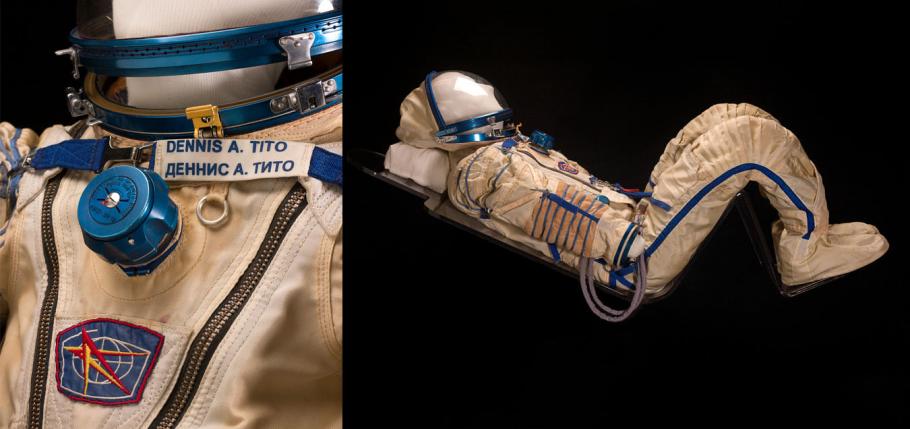
Dennis Tito wore this suit when he launched to the International Space Station on April 28, 2001. (Smithsonian Institution)
Although space itself remained inaccessible to private citizens until the 21st century, other places where Earth and space meet—such as National Aeronautics and Space Administration (NASA) centers—have long been popular destinations for a different kind of space tourist.
The Space Age dawned in the golden age of the family road trip. Thanks to the proliferation of private automobile ownership, an expanding interstate highway system, and the advent of more generous vacation policies in the workplace, Americans ventured from home in greater numbers in the 1960s than at any earlier time in the nation’s history. Millions of these travelers included on their itineraries NASA centers, particularly those with ties to the human spaceflight program: the George C. Marshall Space Flight Center in Huntsville, Alabama; the John F. Kennedy Space Center in Brevard County, Florida; and the Manned Spacecraft Center (known since 1973 as the Johnson Space Center) in Houston, Texas.
NASA centers were not prepared for the tourists who appeared en masse outside their gates. In the early 1960s, the centers operated much like—and were often physically adjacent to—secure military installations. For reasons of national security, the centers restricted access to official visitors only. In response to curious onlookers, the centers developed ad hoc visitor programs. At the same time, proactive civic leaders and enterprising business-people responded to the presence of space center tourists by developing their own space-themed attractions, including museums, halls of fame, and amusement parks, and amenities, such as motels, hotels, and restaurants.
At the Kennedy Space Center, for example, public affairs officers facilitated increasing access to NASA’s launch complex between 1964 and 1967. Their efforts began while the spaceport was under construction with a modest roadside trailer featuring wall-mounted exhibitions. They soon expanded visitor programming to include self-guided driving tours on weekends and holidays during breaks in construction activity. In 1966, the space center partnered with Trans World Airlines (TWA) to operate an escorted bus tour program.

Trans World Airlines (TWA) operated the bus tour program at the Kennedy Space Center in the 1960s. (NASA/KSC Spaceport News)
The following year, the Visitor Information Center opened to the public. It featured indoor exhibition and presentation facilities, an outdoor “rocket garden” that became a popular backdrop for family photos, and a depot for the bus tour program. The architect included all the amenities a traveler might need, such as restrooms, food concessions, a gift shop, and a pay phone, which is now on display at our Steven F. Udvar-Hazy Center. Shaped like a Mercury capsule, the pay phone was painted in a playful tropical teal color, which was en vogue at other Florida attractions at the time. Since 1967, the Visitor Information Center has continued to evolve and expand, reflecting developments in spaceflight and the evolving expectations of 21st century vacationers. Some 1.5 million people visit annually.
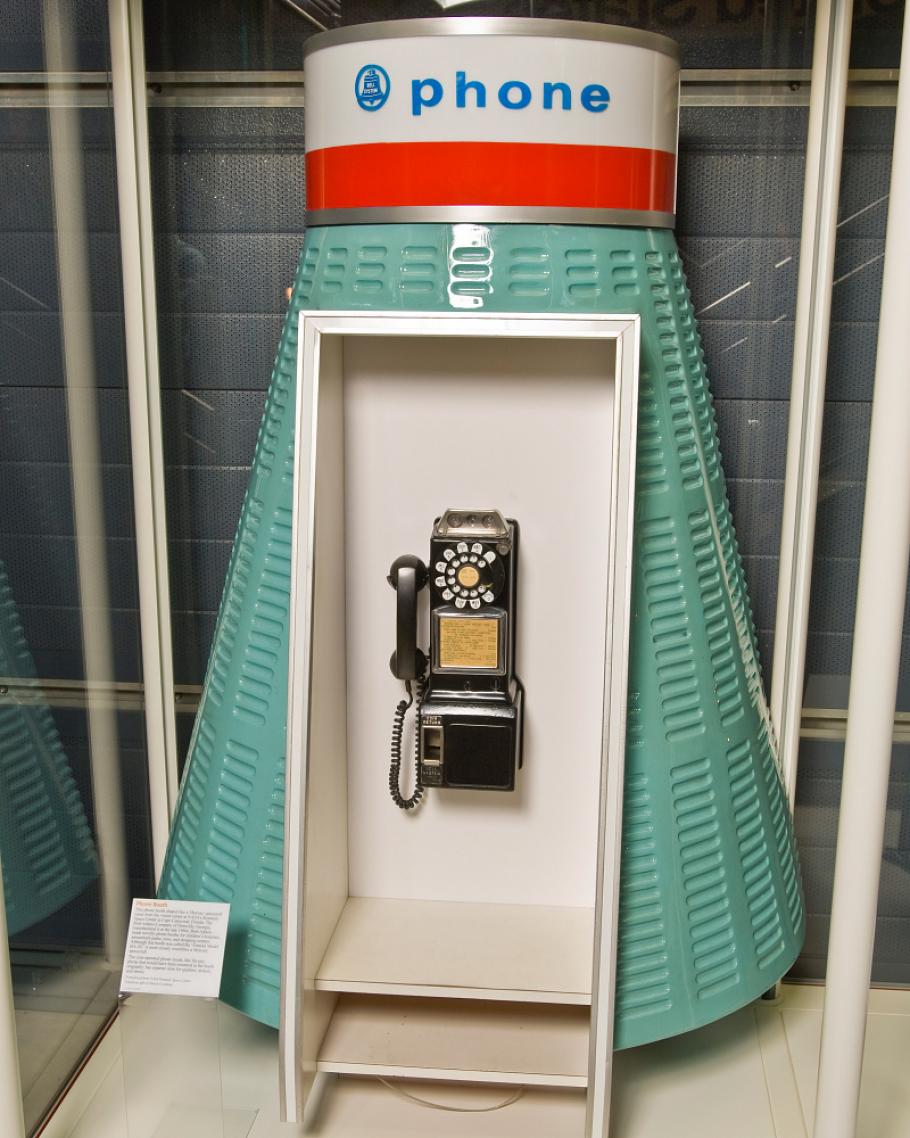
This phonebooth was installed at the Visitor Information Center at NASA’s Kennedy Space Center during the 1960s. (Smithsonian Institution)
Whether venturing to space, visiting a spaceport, or engaging in space-related recreation, individuals and families are likely to continue the tradition of incorporating space activities as part of their leisure time. As we enter the next chapter in the history of space tourism, questions about the significance of these experiences endure: What do “space tourists” hope to gain from their encounter with space or space sites? What does their choice of vacation destination say about their individual identities and the cultural significance of space? Who has access to these experiences and who is left out? And how will space tourism reshape communities on Earth as the industry evolves?
We rely on the generous support of donors, sponsors, members, and other benefactors to share the history and impact of aviation and spaceflight, educate the public, and inspire future generations. With your help, we can continue to preserve and safeguard the world’s most comprehensive collection of artifacts representing the great achievements of flight and space exploration.
- Get Involved
- Host an Event
Thank you. You have successfully signed up for our newsletter.
Error message, sorry, there was a problem. please ensure your details are valid and try again..
- Free Timed-Entry Passes Required
- Terms of Use
More From Forbes
When will we have civilian space travel.
- Share to Facebook
- Share to Twitter
- Share to Linkedin
People have been dreaming of going into space for a long time. From the many space movies to iconic television shows and books, civilian space travel has been an ongoing topic for a while. The first civilians may finally be able to enter space in 2021.
A SpaceX Falcon 9 rocket lifts off from pad 40 at Cape Canaveral Space Force Station on January 24, ... [+] 2021 in Cape Canaveral, Florida. The Transporter-1 mission is the first in a planned series of small satellite rideshare missions that will take 143 U.S. and international spacecraft, including 10 Starlink satellites, to low earth orbit, a record number of satellites on a single flight. (Photo by Paul Hennessy/NurPhoto via Getty Images)
Inspiration4
Several companies and initiatives are competing to launch the first civilians into space.
It appears the Inspiration4 may be the first civilian space travel mission in partnership with SpaceX. If all goes according to plan, the world's first four civilian astronauts will launch in 2021. The crew will launch from the Kennedy Space Center in Florida, where the Apollo and Space Shuttle missions launched from. It will be between 2 and 4 days with a low earth orbit that covers 90% of the world's population.
This mission will use the same Dragon vehicle that was successfully docked at the International Space Station with four professional astronauts in late 2020.
Sports fans watching Super Bowl LV on February 7, 2021, may recall seeing a 30-second commercial from Inspiration4 and its leader, Jared Isaacman. Jared Isaacman is the commander and benefactor. He is an accomplished pilot with experience flying commercial and military aircraft. Isaacman also flies in the charitable Black Diamond Jet Team.
This tv spot helps the average person learn about the Inspiration4 mission and encourages people to apply for the two remaining seats. In addition to being the first civilian space travel mission, Inspiration4 helps raise awareness and funds for St. Jude's Children's Hospital.
Best Travel Insurance Companies
Best covid travel insurance plans.
The second seat is titled, Hope. A St. Jude's ambassador with direct ties to the Inspiration4 mission will fill this seat.
The two open seats are awarded to applicants that achieve a specific social mission:
- Generosity: An individual that donates to St. Jude's
- Prosperity: An entrepreneur that has used Shift4 Shop to launch a business
Crew selection for the remaining seats starts in March 2021. The selected crew will undergo astronaut training and fly into space on the SpaceX Dragon Spacecraft.
It appears at this time that SpaceX will be the first company to win the civilian space race if Inspiration4 materializes. SpaceX is led by entrepreneur Elon Musk, who is perhaps better known as the public face of the Tesla vehicle brand.
Currently, SpaceX is launching satellites with its Starlink program. The company has also been announcing several "space tourism" partnerships that hope to launch in the next few years.
Civilians will use the Dragon capsule that holds up to 7 astronauts. But the initial flights will only take four people to space at a time.
Axiom Space
Axiom Space is building the first private space station where space tourists can potentially live in space for several days in the future. For now, Axiom is launching its first private-crew mission to the International Space Station in 2021.
Once civilian space travel starts, they will be guided by professional astronauts. These initial missions provide training opportunities for the space crew and companies. The first initial civilian space flight is planned for early 2022. Four people will fly to stay at the International Space Station for ten days.
Space Adventures
Space Adventures is one of the older space tourism companies and launched in 1998. The company reports successfully sending private citizens to the International Space Station using the Russian Soyuz rocket. Space Adventures also hopes to use the SpaceX Falcon rockets to launch civilians into space from Florida.
If approved, Space Adventures will launch from Florida. There will be a five-day low-Earth orbit that won't dock to the International Space Station. The target date is from late 2021 to early 2022.
Yusaka Maezawa
Japanese billionaire Yusaka Maezawa is striving to be the first civilian to orbit the moon. He signed a partnership with SpaceX for this "moonshot project" to fly on the Big Falcon Rocket and complete the mission by 2023.
Blue Origin
Blue Origin is another leading space tourism company led by Amazon founder Jeff Bezos. In early February 2021, Bezos announced he was stepping down as Amazon CEO to spend more time focusing on his other projects. One of them is Blue Origin.
11-Minute Space Flights
Blue Origin will be offering low-earth orbit flights from its western Texas launch site. The New Shephard rocket system will take up to 6 civilians to the fringe of space above the Karman Line for 11 minutes.
Passengers will arrive two days before the flight to undergo training. While in space, passengers can experience the zero-G weightless experience and look out the large windows to see space and Earth. Civilians will re-enter the Earth and land in the desert near El Paso, Texas, in the capsule via parachute.
Prices for this space expedition are not publicly available on the Blue Origin website. However, some rumors indicate the ticket is at least $200,000 to $250,000 per person.
The last NASA lunar landing took place in 1972. Today, countries are interested in returning to the moon. For instance, the United States wants to send the first female to the Moon by 2024. The U.S. government has a competition to choose a new lunar lander as part of its Artemis program. If successful, people will live on the Moon full-time.
Blue Origin's offering is the Blue Moon vehicle. There are a cargo version and a NASA Human Landing System that's a joint effort with Lockheed Martin, Northrop Grumman and Draper.
Virgin Galactic
As part of the "Virgin" family led by Richard Branson, Virgin Galactic operates from Spaceport America in New Mexico. Like the other space tourism companies, Virgin Galactic is currently in the test flight phase of its SpaceShipTwo vehicle but hopes to onboard civilians soon.
SpaceShipTwo
The first Virgin Galactic space flights will use SpaceShipTwo. This craft holds up to six passengers, and each ticket costs at least $250,000.
Similar to the Blue Origin New Shephard flights, only several minutes will be in space. But the total flight time from takeoff to landing will be approximately 2.5 hours.
International Space Station
In the future, Virgin Galactic will offer missions to the International Space Station. Few specifics are available in regards to cost and the number of days in space. But civilians can join the inquiry list to start the space travel process.
Civilian space travel may finally become a reality starting later in 2021. However, there are safety and government requirements to conquer first. After that, people can start traveling to the edge of space for the experience of a lifetime.
Related Articles:
- Airline Security In A COVID-19 World
- Latest Coronavirus Travel Restrictions January 2021
- Do You Need A Vaccine To Fly?
- Editorial Standards
- Reprints & Permissions
To the Moon, and Beyond: The Realities of Commercial Space Travel
In 2020, the billionaire space race was in full swing. Richard Branson, Jeff Bezos, and Elon Musk were vying to send everyday astronauts into low orbit for the first time. Each of the billionaires successfully launched at least once, and Bezos and Branson were even passengers aboard their own businesses’ rocket ships. Comercial space travel was reaching new heights, and the momentum appeared unstoppable, at least for a time.
Since then, the aftereffects of the global coronavirus pandemic have had noticeably dampened our outlook on space travel: many are less interested in hearing about Blue Origin’s latest design features, and instead are more concerned with domestic events unfolding here on earth. Among these, the war in Ukraine and, as a byproduct, the recent news that Russia has pulled out of the international space station, would seem to further distance us from the final frontier.
However, in recent days, NASA’s ambitions to land on the moon once again with its Artemis mission have recaptured the public imagination for space travel. Although NASA’s initial SLS rocket test recently failed to launch, a second attempt has now been announced for September 27.

If commercial space travel into Earth’s orbit–or even to the moon and beyond–does eventually become a possibility there will still be significant challenges for individuals looking to buy their ticket to the final frontier. Here are just a few of the kinds of issues we will be looking at in the decades ahead.
Costs and Resources
It’s easy to get swept up in the fervor for space travel and believe that we’ll all be living the Jetson lifestyle by the end of the decade. But space travel still requires massive amounts of money, planning, and resources. Even the ever-optimistic Elon Musk puts the minimum cost of space travel at $10 million per flight.
In an interview, Musk stated that the “cost efficiency of SpaceX is the best in history,” and it is “designed to be fully reusable.” This means that, according to Musk’s quick math, the cost of SpaceX is around 5-10% of the Saturn V project (the last rocket to send humans to the moon).
Musk also revealed that significant planning and administrative approval are needed to send rocket ships into and beyond low orbit. The Federal Aviation Administration will need to review SpaceX’s request for space travel and will account for environmental factors and human interests.
The organization has already caught some flack for causing damage to local ecosystems and displacing residents when SpaceX obtained Boca Chica beach in Texas. As resident Mary McConnaughey explained, “They’re here to stay and they want us to leave.” Dealing with disgruntled locals may seem like a trivial matter compared to the boundless cosmos above our heads. But, failing to work collaboratively with the folks here on earth is a genuine hurdle with which all space travelers must contend.
Global Collaboration on Space Travel
A few years ago, space travel seemed to be a beacon of hope for everyone who wanted to see nations work more on collaborative efforts than divisive ones. However, recent news that Russia has pulled out of the space station project has dampened optimism and thrown a wrench in collaborative plans.
Of course, global collaboration for space travel isn’t completely necessary. Independent governmental organizations and billionaires may thrust us into the future. However, a lack of international collaboration will likely slow the space race down rather than speed it up — as scientists will have to guard space-related secrets rather than work in open transparency.
The International Space Station does look set to wind down post-2024. In the meantime, it continues to prove that collaboration is necessary for the kinds of tests and experiments needed to solve the realities of space travel. Even Russia, which positions itself as a global powerhouse, doesn’t have the means to create a space station of its own.
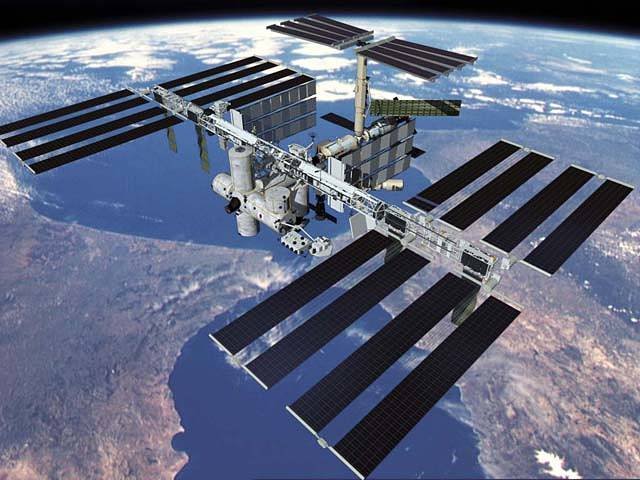
Former ISS commander, Dr. Leroy Chaio, explains, “They [Russia] don’t have the money to build their own station” and will be left with no access to a space station without the ISS. This will further compound collaborative space travel issues, as the European Space Agency has already ended collaboration with the Russian Roskosmos project.
Things could, theoretically, get worse if collaboration turned into a competition. Space travel could be susceptible to cyber war as Nation State Actors exploit vulnerabilities. Governmental agencies and corporations will have to use AI to detect hackers and malicious activities in real-time. AI-led behavior detection may have to prevent bad actors from gaining access to rocketships and ensure that passengers have a safe living and working environment in space.
Life in Space
When we think of space travel, most people imagine floating through hallways, eating dehydrated dinners, and staring into the void for hours on end. All of these activities underline a less-thought-of reality: life in space would be lonely.

AI-Scientists May Usher in A Bright Future in the Search for Extraterrestrial Intelligence Scientific progress may accelerate when artificial intelligence (AI) will explore data autonomously, without the blinders imposed by human prejudice.
Almost all astronauts describe their first journey into space as a life-altering experience. However, that doesn’t mean that the folks who live and work beyond the earth’s surface won’t fall foul of burnout. The myth that, in 1972, astronauts at SkyLab went on strike due to ignored requests to lighten their workload has now been proven false. But, the story is an important reminder that burnout is real and can affect us all.
Offering professional social support can prevent loneliness and burnout in space. Social care specialists will be able to help passengers and staff avoid excessive stress and illness by listening to the human issues that folks in space experience. A little pre-planned compassion may go a long way for folks who encounter the enigmatic cosmos for the first time.
Of course, while mental stressors like isolation and confinement might necessitate solutions such as prescribed social time , there are also physical effects that come with living in space — and some of them are downright harmful. Space radiation means suits and structures need sufficient shielding to mitigate cancer risks, while prolonged exposure to low-gravity and weightlessness can lead to muscle and bone density deterioration as well as kidney stones. Fortunately, modern technology helps astronauts monitor and solve these issues with relative ease.
The Path Forward
Significant hurdles still stand in the way of frequent, accessible space travel. As recent world events have shown, costs associated with spaceflight can quickly become an issue, and international politics may stifle progress. If the general public ever reaches space, they’ll need professional social support, and sophisticated software to ensure their travels into the final frontier are managed as safely as possible.
All this taken into consideration, space travel “for the rest of us” is nonetheless slowly becoming a reality — even if that reality is reserved, for now, for billionaire producers of 21st century space technologies, and the similarly wealthy passengers willing to pay the steep prices to tag along. In any case, SpaceX, Blue Origin, and Virgin Galactic have given us hope that many more of us could one day be given an opportunity to take a flight into low orbit, or perhaps even to further distant locales beyond our planet.
Adrian Johansen is a freelance writer whose work focuses on business, tech and marketing. She is especially passionate about issues related to accessibility and sustainability. You can read more of her work at her website .
- Travel, Tourism & Hospitality ›
Leisure Travel
Space tourism - statistics & facts
What is the public’s opinion on space tourism, do the public want to travel to space, key insights.
Detailed statistics
Global sub-orbital space tourism market size 2021-2031, by flight vehicle type
Amount invested globally into space companies by venture capitalists 2013-2022
Equity investments in space companies worldwide 2013-2022, by type
Editor’s Picks Current statistics on this topic
Current statistics on this topic.
Travel, Tourism & Hospitality
Forecast revenue of orbital space travel and tourism worldwide 2021-2030
Share of U.S. adults who want to travel to space 2021
Related topics
Recommended.
- Space industry worldwide
- Space Mining
- Tourism worldwide
- Travel and tourism in the U.S.
- Aviation and aerospace industries in Germany
- European aerospace industry
- Aerospace industry in Japan
Recommended statistics
Market overview.
- Premium Statistic Global sub-orbital space tourism market size 2021-2031, by flight vehicle type
- Premium Statistic Forecast revenue of orbital space travel and tourism worldwide 2021-2030
- Premium Statistic Amount invested globally into space companies by venture capitalists 2013-2022
- Premium Statistic Equity investments in space companies worldwide 2013-2022, by type
- Premium Statistic Share of investment deals in space start-ups worldwide by company in 2020
- Premium Statistic Distribution of space start-up investors by type 2000-2020
Sub-orbital space tourism market size worldwide in 2021, with a forecast for 2031, by flight vehicle type (in million U.S. dollars)
Forecast revenue of the orbital space travel and tourism market worldwide from 2021 to 2030 (in million U.S. dollars)
Amount venture capitalists invested into space companies worldwide from 2013 to 2022 (in billion U.S. dollars)
Cumulative equity investment in space companies worldwide from 2013 to 2022, by type (in billion U.S. dollars)
Share of investment deals in space start-ups worldwide by company in 2020
Distribution of investment deals on space start-ups worldwide in 2020, by company
Distribution of space start-up investors by type 2000-2020
Distribution of investor groups in space start-ups from 2000 to 2020, by investor type
Public opinion
- Premium Statistic U.S. public opinion on which private space companies are leading the space race 2021
- Premium Statistic U.S. opinion on which private space companies are leading the space race 2021, by age
- Premium Statistic Share of U.S. adults that believe space travel should be accessible to everyone 2021
- Premium Statistic U.S. public opinion on profitability of space exploration companies in future 2021
- Premium Statistic U.S. adults that believe billionaires should spend money on space travel 2021
U.S. public opinion on which private space companies are leading the space race 2021
Public opinion on which space companies are leading the private sector's push into space in the United States as of December 2021
U.S. opinion on which private space companies are leading the space race 2021, by age
Public opinion on which space companies are leading the private sector's push into space in the United States as of December 2021, by generation
Share of U.S. adults that believe space travel should be accessible to everyone 2021
Share of adults that believe space travel should be accessible to everyone and not just those that can afford the costs in the United States as of September 2021
U.S. public opinion on profitability of space exploration companies in future 2021
Share of the public that believe private companies focused on space exploration will make a profit in the next 10 years in the United States as of December 2021
U.S. adults that believe billionaires should spend money on space travel 2021
Share of adults that believe billionaires should be spending money traveling to space in the United States as of September 2021
Traveler interest
- Premium Statistic Share of U.S. adults who want to travel to space 2021
- Premium Statistic Share of U.S. adults who want to travel to space 2021, by gender
- Premium Statistic Share of the U.S. public who would go to the moon if money was not a factor 2021
- Premium Statistic Share of the U.S. public who would go to the moon in 2021, by generation
- Premium Statistic Share of the U.S. public who would go to the moon in 2021, by gender
- Premium Statistic Share of U.S. adults who would travel to the moon 2021, by age
- Premium Statistic Share of U.S. adults who would spend over 100 thousand USD to travel to space 2021
Share of adults that would want to travel to space if money was not an issue in the United States as of September 2021
Share of U.S. adults who want to travel to space 2021, by gender
Share of adults that want to travel to space if money was not an issue in the United States as of September 2021, by gender
Share of the U.S. public who would go to the moon if money was not a factor 2021
Share of the public that would go to the moon as a tourist if money was not a factor in the United States as of December 2021
Share of the U.S. public who would go to the moon in 2021, by generation
Share of the public that would go to the moon as a tourist if money was not a factor in the United States as of December 2021, by generation
Share of the U.S. public who would go to the moon in 2021, by gender
Share of the public that would go to the moon as a tourist if money was not a factor in the United States as of December 2021, by gender
Share of U.S. adults who would travel to the moon 2021, by age
Share of adults that would travel to the moon in the United States as of May 2021, by age
Share of U.S. adults who would spend over 100 thousand USD to travel to space 2021
Share of adults that would spend more than 100 thousand U.S. dollars to travel to space in the United States as of September 2021
Further reports Get the best reports to understand your industry
Get the best reports to understand your industry.
- Space tourism
Mon - Fri, 9am - 6pm (EST)
Mon - Fri, 9am - 5pm (SGT)
Mon - Fri, 10:00am - 6:00pm (JST)
Mon - Fri, 9:30am - 5pm (GMT)
- About Space Future
- Masthead & Credits

- What's New
- Space Tourism
- Space Habitat
- Space Power
- Space Vehicles
- Front Page
- Who's Who
- Glossary of Terms
- Introduction
There are currently 222 documents in the archive.
Here are some key documents from the archive to get you started:
- What the Growth of a Space Tourism Industry Could Contribute to Employment, Economic Growth, Environmental Protection, Education, Culture and World Peace
- Space Tourism Market Demand and the Transportation Infrastructure
- General Public Space Travel and Tourism
- Artificial Gravity and the Architecture of Orbital Habitats
- Prospects of Space Tourism
- Directory of Contents
- Space Tourism
- Space Vehicles
- Space Habitat
- Space Power
- Space Future Journal
- Papers & Publications
- Bibliography
- Glossary of Terms
- Links to Other Sites
- How Much Do You Know About Space
- Space Future Editor Wins NewSpace Journalism Award
- China's First Manned Docking of Space Module Is a Success
- Five Horrifying Facts
- NASA Will Pay You to Eat Astronaut Food
- Attention Teachers: If You Don't Apply to This Workshop
- Space Is Dirty
- The Film That NASA Banned
- SRI holds Inaugural Conference
- Zubrin's Proposal to Fund "Pathway to the Stars"
Experimental flight regulations; spaceport regulations Waiver of liability; space traffic management
Use of government assets; privatization of zero-gravity flights Authority to license reentry vehicles
Certification of commercial transport systems operations Property rights: claims registry, deeds and liens, noninterference Environment: noise and debris, overland supersonic flights Removal or mitigation of orbital debris Financial, Economic, Business Planning and Market Considerations
Buzz Aldrin (Starcraft Enterprises) Robert Armstrong ( NASA Marshall Space Flight Center) Victoria Beckner ( LunaCorp , Inc.) Ivan Bekey (BDI; Initial NASA Study Lead) Collette Bevis ( X Prize Foundation) William Blerbauer (Lawyer) Gloria Bohan (Omega World Travel) Steve Brody ( NASA OSS/Mission From Planet Earth Office) Keith Calhoun-Senghor (DOC/Office of Air & Space Commercialization) Robert A Citron ( Kistler Aerospace ) Kelvin B Coleman (DOT/ FAA /Office of Comm. Space Transportation) Ed Cooper (Omega World Travel) Peter H Diamandis ( X Prize Foundation) Marcus Dinsmore (Omega World Travel) Norman Fast (F.B. Partners/Incredible Adventures) Stephen Fogleman ( NASA OLMSA; General Participant) Jerry Grey ( AIAA ) David Gump ( LunaCorp , Inc.) Robert L Haltermann (Haltermann & Associates) Rick Hauck (AXA Space) Professor Donald E. Hawkins (George Washington University) Patt Hill (Omega World Travel) Joe Howell ( NASA Marshall Space Flight Center) Walter Kistler ( Kistler Aerospace ) Sandra Morey Kreer (Travel Network) Chuck Larsen (DOT/ FAA /AST) Charles J Lauer (Orbital Properties, LLC) John C Mankins ( NASA Study Lead) Gregg Maryniak ( X-Prize Foundation) Neville Marzwell (California Institute of Technology) Wallace McClure ( Boeing North American) Tidal W McCoy (Thiokol) James Muncy (House of Representatives Staff) Dan O'Neil ( NASA Study Organizer) Scott Pace (RAND/Critical Technologies Institute) Michael R Paneri (Wimberly, Allison, Tong and Goo) William M Piland ( NASA Langley Research Center) Gene Pinder (US Space & Rocket Center) Carl S Rappaport (DOT/Office of Commercial Space Transportation) Tom Rogers ( STA Study Lead) Larry Rowell ( NASA Langley Research Center) T C Schwartz (T.C.S. Expeditions) Charles Scottoline ( Boeing North American (ret.); General Participant) David Smitherman ( NASA Marshall Space Flight Center) Eric W Stallmer ( STA Study Organizer) Thomas C Taylor (Global Outpost, Inc.) Harvey Willenberg ( Boeing Defense and Space Group) Lawrence R Young (MIT) John Spencer (Design Finance International) Harvey Wichman (Claremont McKenna College) Howard Wolff (Wimberly, Allison, Tong and Goo) Gordon Woodcock (Consultant) Dr. Molly Brennan (CCI; Workshop Organizer) Jack Pozza (CCI; Workshop Organizer)

NTRS - NASA Technical Reports Server
Available downloads, related records.

Suggested Searches
- Climate Change
- Expedition 64
- Mars perseverance
- SpaceX Crew-2
- International Space Station
- View All Topics A-Z
Humans in Space
Earth & climate, the solar system, the universe, aeronautics, learning resources, news & events.

NASA’s Fermi Mission Sees No Gamma Rays from Nearby Supernova

The Ocean Touches Everything: Celebrate Earth Day with NASA

The April 8 Total Solar Eclipse: Through the Eyes of NASA
- Search All NASA Missions
- A to Z List of Missions
- Upcoming Launches and Landings
- Spaceships and Rockets
- Communicating with Missions
- James Webb Space Telescope
- Hubble Space Telescope
- Why Go to Space
Astronauts Home
- Commercial Space
Destinations
Living in Space
- Explore Earth Science
- Earth, Our Planet
- Earth Science in Action
- Earth Multimedia
- Earth Science Researchers
- Pluto & Dwarf Planets
- Asteroids, Comets & Meteors
- The Kuiper Belt
- The Oort Cloud
- Skywatching
- The Search for Life in the Universe
- Black Holes
- The Big Bang
- Dark Energy & Dark Matter
- Earth Science
- Planetary Science
- Astrophysics & Space Science
- The Sun & Heliophysics
- Biological & Physical Sciences
- Lunar Science
- Citizen Science
- Astromaterials
- Aeronautics Research
- Human Space Travel Research
- Science in the Air
- NASA Aircraft
- Flight Innovation
- Supersonic Flight
- Air Traffic Solutions
- Green Aviation Tech
- Drones & You
- Technology Transfer & Spinoffs
- Space Travel Technology
- Technology Living in Space
- Manufacturing and Materials
- Science Instruments
- For Kids and Students
- For Educators
- For Colleges and Universities
- For Professionals
- Science for Everyone
- Requests for Exhibits, Artifacts, or Speakers
- STEM Engagement at NASA
- NASA's Impacts
- Centers and Facilities
- Directorates
- Organizations
- People of NASA
- Internships
- Our History
- Doing Business with NASA
- Get Involved
- Aeronáutica
- Ciencias Terrestres
- Sistema Solar
- All NASA News
- Video Series on NASA+
- Newsletters
- Social Media
- Media Resources
- Upcoming Launches & Landings
- Virtual Events
- Sounds and Ringtones
- Interactives
- STEM Multimedia

Comet Geyser: Perseverance’s 24th Rock Core

NASA’s Dragonfly Rotorcraft Mission to Saturn’s Moon Titan Confirmed

Kate A. McGinnis: Ready to “Go” with PACE Testing

NASA Open Science Initiative Expands OpenET Across Amazon Basin

NASA Motion Sickness Study Volunteers Needed!

NASA Selects New Crew for Next Simulated Mars Journey

A.3 Ocean Biology and Biogeochemistry Inclusion Plan Correction

NASA Goddard to Build Quake Detector for Artemis III Moon Landing

A Solar Neighborhood Census, Thanks to NASA Citizen Science


Hubble Spots a Galaxy Hidden in a Dark Cloud

Amendment 9: New Opportunity: C.26 Rapid Mission Design Studies for Mars Sample Return

NASA Langley Team to Study Weather During Eclipse Using Uncrewed Vehicles

ARMD Solicitations

NASA Noise Prediction Tool Supports Users in Air Taxi Industry

Tech Today: Folding NASA Experience into an Origami Toolkit

NASA’s SERT II: ‘A Genuine Space Success Story’
Earth Day 2024: Posters and Virtual Backgrounds

NASA Names Finalists of the Power to Explore Challenge

NASA Partnerships Bring 2024 Total Solar Eclipse to Everyone

NASA Receives 13 Nominations for the 28th Annual Webby Awards

La presentación del X-59 de la NASA personifica la tradición aeronáutica
Why go to space.
The reasons to explore the universe are as vast and varied as the reasons to explore the forests, the mountains, or the sea. Since the dawn of humanity, people have explored to learn about the world around them, find new resources, and improve their existence.
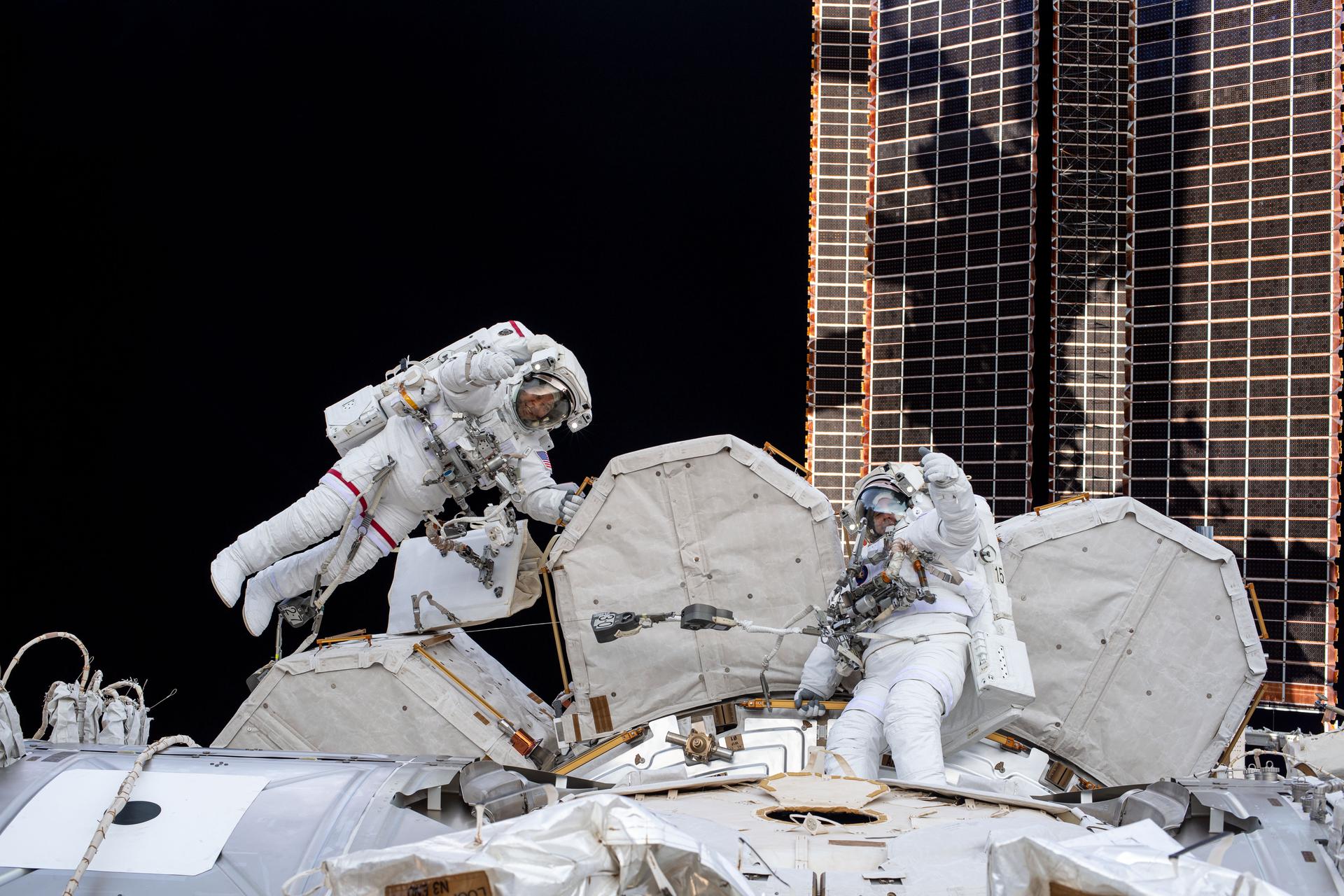
Why We Go to Space
At NASA, we explore the secrets of the universe for the benefit of all, creating new opportunities and inspiring the world through discovery.
NASA’s exploration vision is anchored in providing value for humanity by answering some of the most fundamental questions: Why are we here? How did it all begin? Are we all alone? What comes next? And, as an addendum to that: How can we make our lives better?
NASA was created more than half a century ago to begin answering some of these questions. Since then, space exploration has been one of the most unifying, borderless human endeavors to date. An international partnership of five space agencies from 15 countries operates the International Space Station, and two dozen countries have signed the Artemis Accords, signaling their commitment to shared values for long-term human exploration and research at the Moon. Through space exploration, we gain a new perspective to study Earth and the solar system. We advance new technologies that improve our daily lives, and we inspire a new generation of artists, thinkers, tinkerers, engineers, and scientists.
Benefits to Humanity
Space exploration unites the world to inspire the next generation, make ground-breaking discoveries, and create new opportunities.
Technologies and missions we develop for human spaceflight have thousands of applications on Earth, boosting the economy, creating new career paths, and advancing everyday technologies all around us.
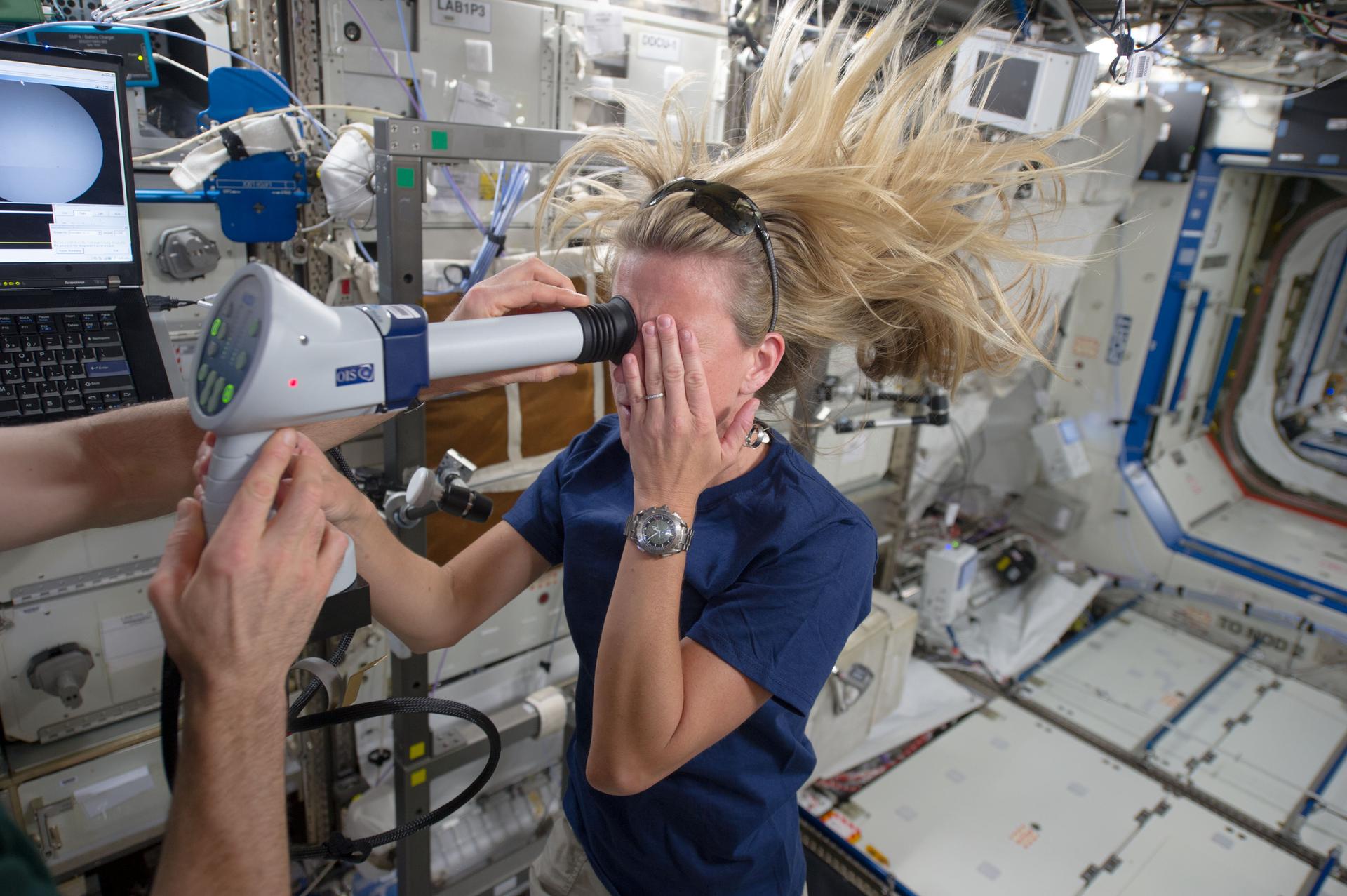
To view this video please enable JavaScript, and consider upgrading to a web browser that supports HTML5 video
Benefits to Science
The pursuit of discovery drives NASA to develop missions that teach us about Earth, the solar system, and the universe around us.
Science at NASA answers questions as practical as hurricane formation, as enticing as the prospect of lunar resources, as surprising as behavior in weightlessness, and as profound as the origin of the Universe.

Unite with us on our journey to explore.
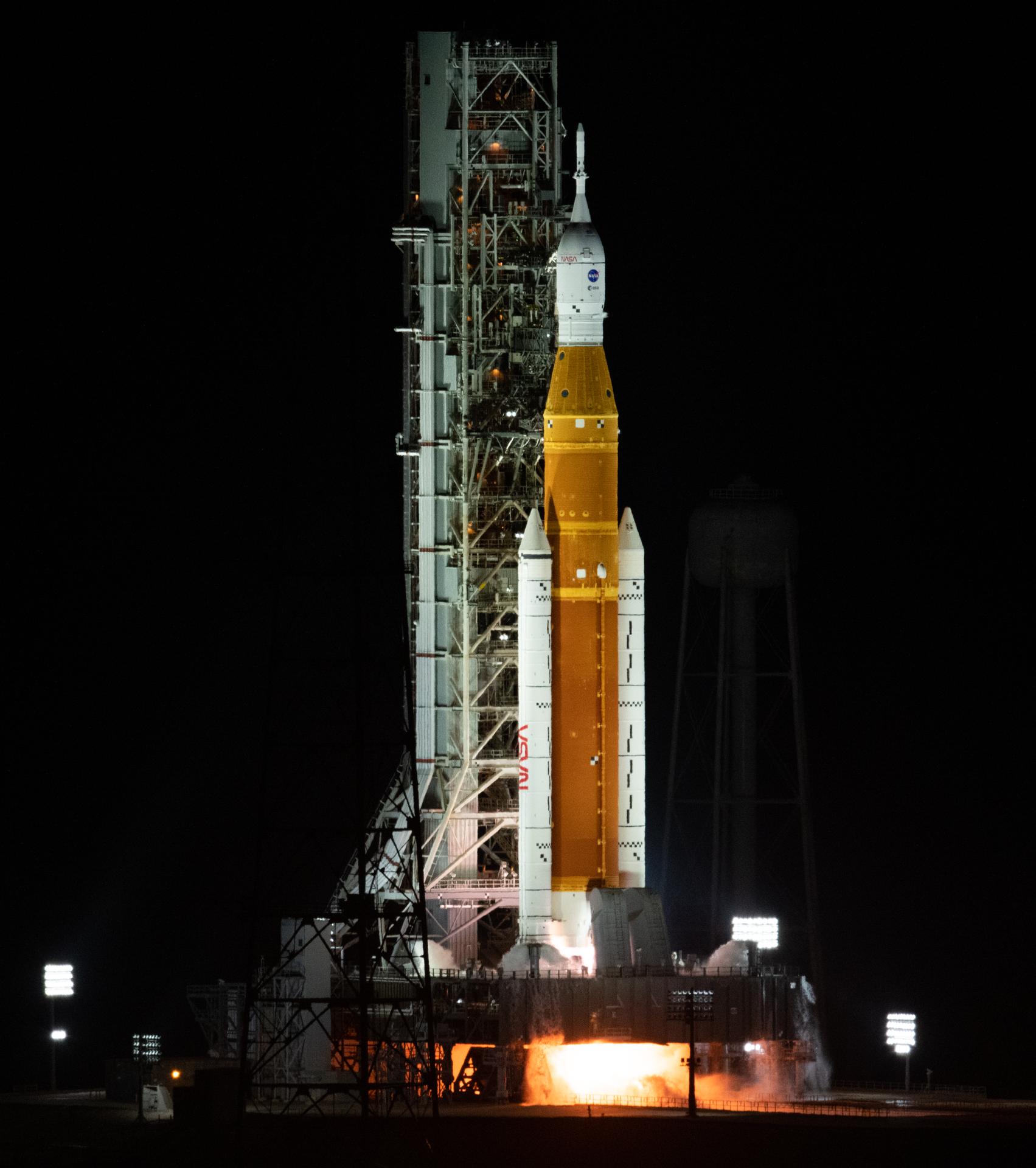
Discover More Topics From NASA

Public Space Travel: Reality or Mirage?

MOJAVE, California – Today's planned unveiling of SpaceShipTwo here at the Mojave Air and Space Port is generating high-altitude hope and a good dose of hype for public space travel , yet there are those who wave an advisory flag.
One such person is Roger Launius, Senior Curator in the Division of Space History at the Smithsonian Institution's National Air and Space Museum in Washington, D.C.
SpaceShipTwo is a carbon composite kissing cousin to SpaceShipOne – the non-governmental, single piloted craft that bagged the $10 million Ansari X Prize purse by flying repeat treks to suborbital space in 2004.
Launius measures up those early flights of SpaceShipOne and the promissory note it delivered in terms of flying future rubbernecking space tourists.
"It seems to me that five years after the flight of SpaceShipOne, space tourism, while still stirring because of its promise of allowing anyone to participate, remains a hazy mirage on the distant horizon. I wish it were otherwise," Launius told SPACE.com via email.
At a basic level, Launius pointed out, tourism at any time and place in human history has required a trio of major components:
- A discretionary income available for leisure travel;
- Ample leisure time to spend on both preparations for and taking the trips themselves; and
- An infrastructure supporting tourism that offers accommodations, food and amenities, transportation systems, and attractions to see and do at the place visited.
"None of these three components are available in abundance for space tourism, although all exist to a small degree," Launius said. "They will have to be created or expanded significantly to achieve the goal of opening space to the public. This will be a challenging task involving significant investment, especially in infrastructure, and either a significant reduction in the costs of space tourism to broaden the market or a greater attraction for those with enormous fortunes to spend on their leisure activities."
Get the Space.com Newsletter
Breaking space news, the latest updates on rocket launches, skywatching events and more!
Launius suggested that, in the next few years, there seems "good reason" to believe that sub-orbital space tourism will become a reality.
"It may well remain the province of wealthy thrill-seekers, essentially the same class of those who climb Mount Everest, rather than the masses who dominate the current $600 billion-plus per year tourism industry."
Furthermore, a tiny elite of multi-millionaires, Launius explained, may continue to fly aboard Soyuz capsules to Earth orbit, but the reality is that orbital space tourism is many decades away absent a major breakthrough in space access. "Until that happens we may be able to count the number of orbital space tourists on our fingers for years to come," he said.
Drawing upon his aerospace history background, Launius said that a useful analogy illustrating this problem might be the transition from propeller-driven aircraft to jets during World War II.
"By the 1930's, propulsion engineers had squeezed most of the performance that they could out of reciprocating engines. To reach a new plateau of performance they needed a new propulsion technology. Jet engines revolutionized the nature of flight, and made economical for the first time mass movement of people by air," Launius said.
Perhaps there is some propulsion breakthrough that will revolutionize space access and make tourism a reality, Launius continued. "At present, engineers are industriously modifying existing technologies to squeeze out of them a few more percentage points of capability."
While Launius is hopeful of being wrong, and that this analogy does not hold true for space tourism, "but if it does, this is a prescription for the adventurers to reach space -- most of them sub-orbital -- but not for space tourism as most envision it," he concluded.
- More About the Planned SpaceShipTwo Unveiling
- Future of Flight: Space Tourism, Investment and Technology
- VIDEO: Virgin Galactic: Let the Journey Begin
Leonard David has been reporting on the space industry for more than five decades. He is past editor-in-chief of the National Space Society's Ad Astra and Space World magazines and has written for SPACE.com since 1999.
Join our Space Forums to keep talking space on the latest missions, night sky and more! And if you have a news tip, correction or comment, let us know at: [email protected].

Leonard David is an award-winning space journalist who has been reporting on space activities for more than 50 years. Currently writing as Space.com's Space Insider Columnist among his other projects, Leonard has authored numerous books on space exploration, Mars missions and more, with his latest being "Moon Rush: The New Space Race" published in 2019 by National Geographic. He also wrote "Mars: Our Future on the Red Planet" released in 2016 by National Geographic. Leonard has served as a correspondent for SpaceNews, Scientific American and Aerospace America for the AIAA. He was received many awards, including the first Ordway Award for Sustained Excellence in Spaceflight History in 2015 at the AAS Wernher von Braun Memorial Symposium. You can find out Leonard's latest project at his website and on Twitter.
Space-based solar power may be one step closer to reality, thanks to this key test (video)
DJI Avata 2 drone review
Will the constellations ever change?
Most Popular
- 2 Switzerland signs Artemis Accords to join NASA in moon exploration
- 3 James Webb Space Telescope full-size model to be displayed by Space Foundation
- 4 Dark energy could be getting weaker, suggesting the universe will end in a 'Big Crunch'
- 5 Solar eclipse 2024: Live updates
- Map of Boston Exhibits
- Map of Istanbul Exhibits
- Timeline of Mumbai Exhibits
- Looking Backward
MOSCOW: Where Public Meets Private
"moscow is a classically arendtian representation of the public realm, as seen in khutsiev’s i am twenty , which serves a portrayal of its open landscape—filled with busy street fares, bustling urban squares, dinner parties, and crowded trains.".

Moscow's public realm, as seen in "I Am Twenty" (54:71).
Moscow is a behemoth of a city filled to its brim with culture, urban sprawl, and people—with a population of a whopping 16.2 million people residing in its urban center, it’s the largest metropolitan city in Europe, outnumbering other giants like London (12.2 million) and Paris (10.9 million). Therefore, it is especially interesting to explore the role of public spaces in this city.
With so much space, Moscow seems to be the ultimate Arendtian representation of the public realm. As explored in the Moscow Omeka blog post focusing on the city’s various parks, urban spaces play an especially important role in Moscow, a city cmoming to terms with its past to enter the world stage as a post-Socialist city. The advent of public space is an important part of discussion for Moscow’s built environment today, with new art exhibits and discussions cropping up recently. “Moskva: urban space” , for example, is a recent exhibit from the 2014 Venice Biennale by the city’s chief architect to explore how “today’s urban singularity is more so based on the ‘connective tissue’ that is the public spaces, and the ways in which these spaces have become equally important markers of contemporary metropolis identities.” [1] This exhibition provides great insight into the sprawl of Moscow and the utter importance of urban spaces in the city.

Beautiful and expansive, Moscow's famous Gorky Park boasts many fountains and a great deal of public space.
Looking at specific examples from this course, Marlen Khutsiev’s 1965 film, I Am Twenty , is the perfect representation of this very public realm in the sprawling city of Moscow, even half a century ago. It’s an exquisitely gorgeous homage to the beautiful city, and much of the film focuses on scenes that occur in the public realm: Sergei and his friends smoking cigarettes around the city late at night or early in the morning; hosting dinner parties where they all converse with one another; and generally just spending a great deal of time outside.

Sergei and his friends have an intimate conversation about their lives out in the open realm—the private realm, still in the public realm.
Above is the perfect example of the Ardentian public sphere as seen in the movie. Sergei and his friends chat about life, love, and everything in between, but with lots of people around. Even in the image captured above, we see not only Sergei and his two friends on screen, but about four other figures walking squarely past the camera, with a beautiful, open square in the back filled with cars, trains, and sprawling public space. Interestingly, the public realm actually allows for the existence of the private realm in many such scenes, which complicates and enriches its role in a way that Sennett or Ardent do not point out. In these moments of public display in busy squares, the characters actually engage in intimate conversations, allowing for the private realm to become seamlessly integrated into the public one.

Anya and Sergei share an intimate moment during the very public May Day parade.
Another scene occurs during the May Day parade, perhaps the most “public” of realms shown in the entire movie. It’s a scene where thousands gather in the streets of Moscow to celebrate the Allied victory in the Eastern front and the surrendering of Nazi Germany. Here, in perhaps the most crowded one might imagine a street, Sergei and Anya meet and share an intimately private moment. They chat and end up on a beautiful night around town together, traipsing about the city—private and intimate, though fully in the public.
All of this sheds light into Moscow as a place of the public realm: while it follows the classic Arendtian description of busy open spaces, there is the caveat that the private realm can exist even in these public busy spaces. This is reflected perfectly through most scenes and interactions throughout the film.
Sources:
[1] Rawn, Evan. "'Moskva: Urban Space'" Investigates the Future of Moscow's Public Realm at the 2014 Venice Biennale. Arch Daily, August 10, 2014.

American Tourists Aggressively Stop Locals in Durango, Mexico from Watching Eclipse in Public Space
O n April 8, many in parts of the United States and Mexico were gearing up to watch the total solar eclipse. In the city of Durango, Mexico, residents were particularly excited because they would enjoy the most visibility of this rare phenomenon. People gathered in public spaces, including one of the most popular spots, the lookout of "El Cerro de los Remedios," which offers panoramic views of the city. However, residents' excitement turned sour when a group of U.S. tourists claimed to have rented the entire front area of the public space, keeping everyone else from accessing prime area with the best vantage point.
As reported by Espacio Libre, a local news and media website that planned on transmitting the eclipse, some of the U.S. tourists were blatantly disrespectful toward locals, claiming that they were having a "private event." The tourist group was accompanied by the assistant secretary of "Planificación y Desarrollo Turístico" ("Tourism Planning and Development"), Olivia Margarita Fernández, who was seemingly involved with the U.S.-based travel agency, "Betchart Expeditions." Fernández supported the group of what seemed to be mostly American tourists by claiming that the area was only accessible to those who had paid to be there. When asked who they paid, she provided no answer.
As reporter José G. Martínez and his cameraman asserted their right to be there; they were met by the entitled attitude of one of the women from the tourist group, later identified as tour guide Tanya Deyoung. In the video shared by Espacio Libre, Deyoung is seen mockingly saying "goodbye" and "adiós, ahora" as she waves them away dismissively. When Martínez refused to leave, she yelled "no" in his face and physically blocked him from entering the area that the foreigners appropriated as theirs.
As the confrontation continued, Deyoung claimed that the tourist group had a "contract" with Fernández for the private use of the space. Martínez and his cameraman didn't back down, and neither did the residents, who also started to speak up. Among them was a young girl who defended her right to be there. She said, "They won't let us in, they're blocking us. They're not respecting the rules. We have priority because we live here. When we go there [to the U.S.], they kick us out. They're acting as if this is their city."
Before the girl could continue, Deyoung interrupted and silenced her, screaming very close to her face, "Please leave our private event!" Then, she continued mockingly saying "adiós" and waving them away.
Eventually, Martínez approached assistant secretary Fernández, asking to see the alleged permit that allowed the foreigners to claim a public space. Espacio Libre was shown a document that turned out to be a request, not a permit. The request was addressed to the Director of "Ferias, Espectáculos y Paseos Turísticos de Durango" ("Fairs, Shows and Sightseeing Tours of Durango"), asking for the space to set up a group of "specialists in various fields to observe the eclipse" from 8 a.m. to 3 p.m.
Martínez noted that the group didn't have any specialized equipment with them, and the request didn't specify what kind of specialists they were. Moreover, they were seen dancing, led by Fernández, an activity usually practiced for entertainment, not scientific observation.
Espacio Libre's investigation revealed that they weren't a group of specialists at all and that the travel agency charged 6,390 USD per person. There were at least 50 people in the group, according to Martínez, which adds up to around 319,500 USD or 5,400,000 MXN. Martínez wondered how much of that money was pocketed by the government of Durango to allow the group of foreigners to appropriate the most privileged spot to watch the solar eclipse.
When Espacio Libre shared clips of these deplorable actions on social media, Durango residents and people all over Mexico and the U.S. were outraged. The video quickly went viral as more and more Latinos reproached the vile attitude of white Americans, who, even in foreign countries, feel entitled to claim any space as theirs. Moreover, many took to Yelp to leave scathing reviews calling out the racist behavior of Betchart Expeditions' staff. Currently, the travel agency's website and Facebook page are temporarily down.
It's speculated that the Department of Tourism Planning and Development carries some of the responsibility by allowing Fernández to rent out a public space. It's not just illegal to do so, but it also violates an essential human right–the freedom of movement. In response to the allegations, the Department of Fairs, Shows and Sightseeing Tours of Durango issued a statement , claiming, "At no time was space rented to foreign tourists at this sighting point. Only a small space was delimited to protect the technological equipment of foreign astronomers."
Many perceive these actions as discriminatory against Mexicans, and the fact that it happened on their own soil, seemingly backed by their own government, makes the situation even more shocking. Below is the full video from Espacio Libre TV on Instagram for the complete story.
Note: the video is in Spanish, no English captions are available on Instagram.
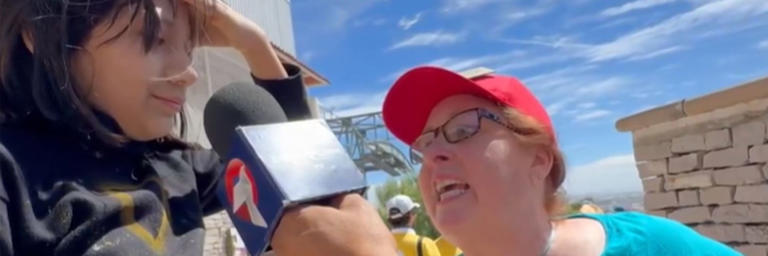
You are using an outdated browser. Please upgrade your browser .
- Gorky Central Park of Culture and Recreation, Moscow
- Guide to Russia
What is the history of Gorky Park?
- In the pre-revolutionary period, Gorky Park was a city dump and wasteland, which was cleared in 1923 to host the All-Russian Agricultural and Artisan Industrial Exhibition
- In 1928, a huge park was planned on the former site of the exhibition. It would not just be a place of leisure, but a place to proudly display Soviet culture and daily life
- Gorky Park has remained a cultural hub ever since, and has been renovated and added to over the years to make it one of Moscow’s top attractions today
Gorky Central Park of Culture and Recreation
Gorky Park is the most famous park of Moscow, created during the Soviet period as a hub for relaxation and cultural activities. The park is beloved by Muscovites and tourists alike, who visit in all seasons to stroll, enjoy sports, admire the park’s attractions, and attend cultural events. Gorky Park is the central part of an ensemble of four green spaces – Muzeon Park of Arts, Neskuchny Garden, and Sparrow Hills Nature Reserve – which curve around the southern bank of the Moskva River to the south-west of Moscow city centre. Here you may spend some time and enjoy nature and contemprary art during your vacation in Moscow .
History of Gorky Park
Imperial russia.
In the 17th century, the eastern bank of the Moskva River beyond Moscow’s city limits was home to floodplain meadows, where palace horses grazed. From the mid-1850s, events such as cockfights, fistfights, and races were held here, and by the 20th century this area had become a city dump where the unemployed and homeless people of Moscow lived, which remained this way until the Soviet period. This wasteland lay in stark contrast to the adjoining Neskuchny Sad – ‘merry garden’ – which lay to its south, an area of aristocratic country estates and elaborate gardens.
Soviet Russia
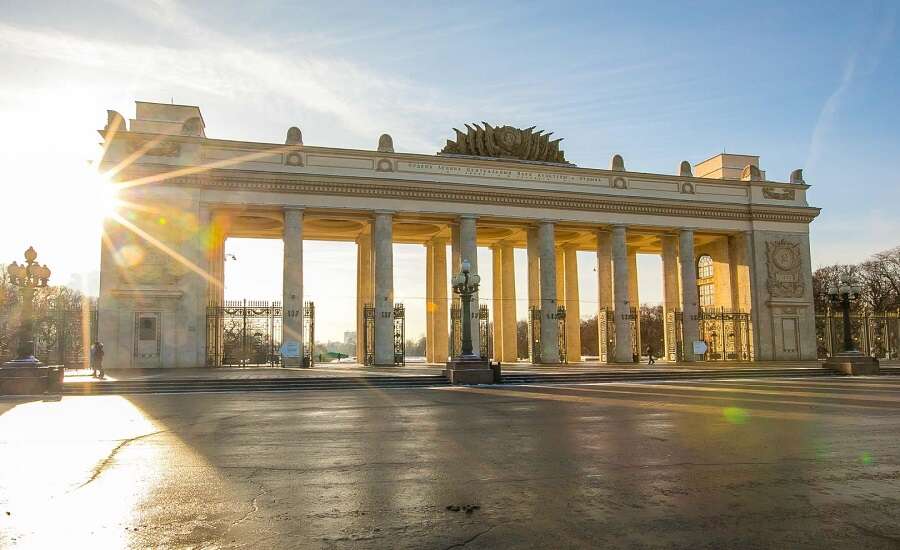
Photo from https://parkseason.ru/
Following the October Revolution, Vladimir Lenin travelled around Moscow to find a suitable site for the first All-Russian Agricultural and Artisan Industrial Exhibition, which would reveal opportunities for socialist development of agriculture and industry. Lenin decided on the wasteland alongside the Moskva River, which was cleared with a programme of community work. In 1923, the exhibition began. It encompassed 250 pavilions dedicated to different themes of agriculture and industry, and was divided into thematic zones, such as villages, livestock, crops, engineering, railways, republics of the USSR, and foreign countries. The organisation of the exhibition demarcated the future layout and size of Gorky Park, and the paths, ‘zones’, and main square of the exhibition have been preserved until the present day. In March 1928, Moscow City Council decided to establish a park of culture and recreation on the site of the former exhibition, which would also encompass the Neskuchny Garden. Moscow’s residents were instrumental in the construction of the park – they voiced their desires for events spaces, physical education and leisure facilities, and gave up their weekends to build the park. The park’s main architect was Konstantin Melnikov.
Did you know? Konstantin Melnikov also helped to construct Lenin’s Mausoleum and the Rusakov Worker’s Club, one of Moscow’s Constructivist masterpieces .
Over 100,000 Muscovites flocked to the opening of the park on 12th August 1928. The brand-new park was equipped with two theatres, a cinema, nursery, reading room, restaurant and café, music stages, sports arenas, rowing boats, and even a giant helter-skelter slide. Unfortunately, because of the vast size of the crowd and the general excitement, the park was damaged and closed until September.
Did you know? The park was not named after Maxim Gorky, writer and founder of Socialist Realism, until 1933.
In 1929, Betty Glan – at the mere age of 26 – became director of the park. She decided to reconceptualise it, uniting leisure, design, and ideology with the help of Moscow’s most eminent architects, designers and artists. Over the next decade, more cultural venues were established in the park, the Pushkinskaya Embankment along the Moskva River was developed, and the landscaping of the park was carefully cultivated. Architect Alexander Vlasov was particularly influential, and won the Grand Prix at the 1937 World Exhibition in Paris for his design of Gorky Park. This period under Glan’s directorship until 1937 was known as the ‘golden age’ of Gorky Park, which became not just a place for recreation, but a public space where Soviet culture and everyday life could be proudly displayed.
Did you know? During the Second World War topical events were held in Gorky Park, such as the championship in bayonet combat, grenade-throwing competitions, and air defence training. What’s more, an exhibition of captured enemy weapons – tanks, artillery, aeroplanes, and more – was organised in Gorky Park and continually updated throughout the war.
In the post-war decades new attractions were continually added to Gorky Park. These included the majestic 24-metre triumphal arch at the entrance to the park, an astronomical observatory (which remains open today), the famous Ferris wheel (unfortunately dismantled in 2008), and a fountain with lights and music.
Russia today
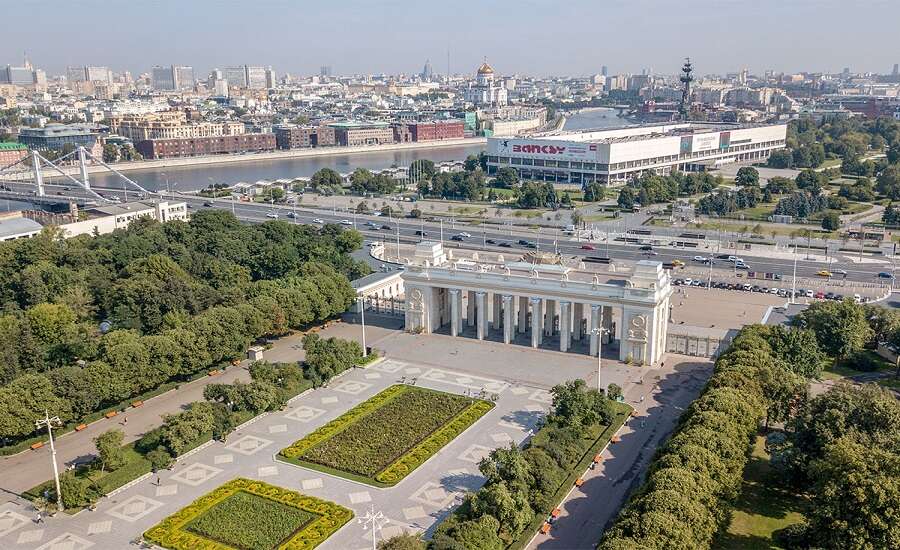
Photo from https://countryscanner.ru/
The Gorky Park ensemble continued to flourish as a centre of culture and recreation in post-Soviet Russia. The adjoining Muzeon Park of Arts was founded in 1992, and Garage Museum of Contemporary Art was established in Gorky Park in 2008. The ensemble underwent serious reconstruction in 2011. Many new sports facilities were added, including centres for beach sports and extreme sports, bicycle paths and sports equipment rental hubs, and much effort was devoted to reviving original buildings, sculptures, and landscape compositions. Two years later, the embankment of the Moskva River from the southern tip of Zamoskvorechye Island all the way to Sparrow Hills was redeveloped and pedestrianised, making it possible to peacefully walk or cycle along the Moskva for many kilometres.
What can you do at Gorky Park today?
- Explore the park and see architectural attractions, fountains, and beautiful gardens
- Visit Garage Museum of Contemporary Art and the Gorky Park Museum
- Go boating on the lakes and stroll down the Pushkinskaya Embankment
- Rent bicycles or scooters, skateboard, and visit the sports centres
What can you do at Gorky Park?
Park attractions.
While exploring the treelined paths of Gorky Park, you’ll come across a number of attractions. To the west of the main entrance, near the river, is a beautiful geometric bandstand used for music and literary evenings in the Soviet period. As you head down the central alley of Gorky Park from the main entrance, you’ll see a statue of Maxim Gorky on your right, and discover the light and music fountain with its dancing jets of water – find the schedule of its performances here .
Did you know? Don’t be afraid to feed the red squirrels and birds you encounter on your walk around Gorky Park – there are even vending machines which sell special food for the animals!
The southern section of Gorky Park is occupied by the Golitsynsky Garden. In 1802, the Golitsyn Hospital was founded here as a hospital for the poor; it still adjoins Gorky Park today. Gardens were created as a relaxation place for patients, extending from the hospital building to the riverbank, and included landscaped gardens, a Chinese Bridge, and two ponds. On the riverbank is the Rotunda of the Golitsyn Hospital, which has been preserved since the 19th century. There is also a rose garden and fountain by the Bolshoi Golitsynsky Pond.
Did you know? In the Golitsynsky Garden is also located an unusual architectural monument – a public toilet designed by Alexander Vlasov in the 1930s, which is recognised as an ‘object of cultural heritage’!
Outdoor activities
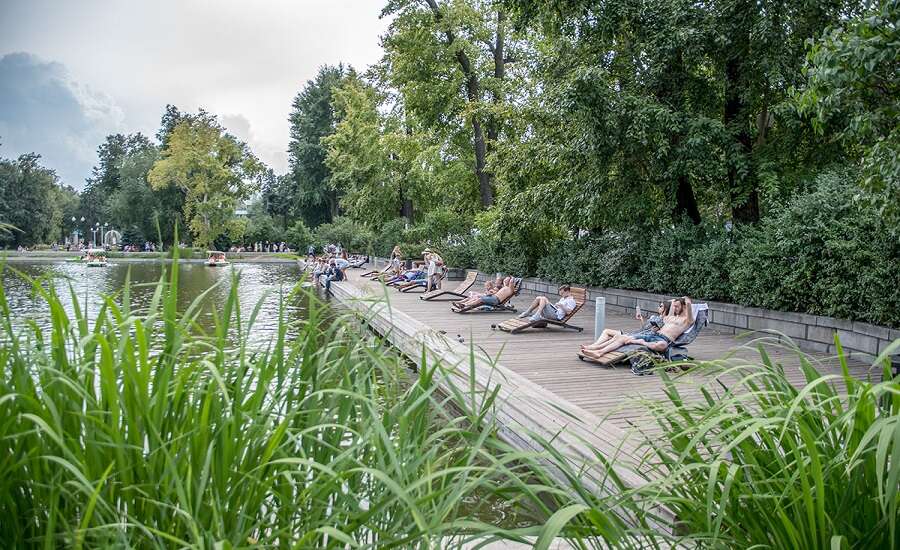
Gorky Park’s extensive and varied grounds aren’t only good for walks! You can relax on the water by renting boats to sail on the Pionersky and Bolshoi Golitsynsky Ponds, or visiting the Olivkovy Beach on the Pushkinskaya Embankment to sunbathe. As well as this, you can hire bicycles, electric scooters, longboards or even roller skates to explore the park and embankments, play table tennis, visit the sports complex to play football, basketball, handball, badminton or volleyball, or visit the Vans skatepark or Nike sports centre for workouts and classes such as rooftop yoga.
Gorky Park Museum
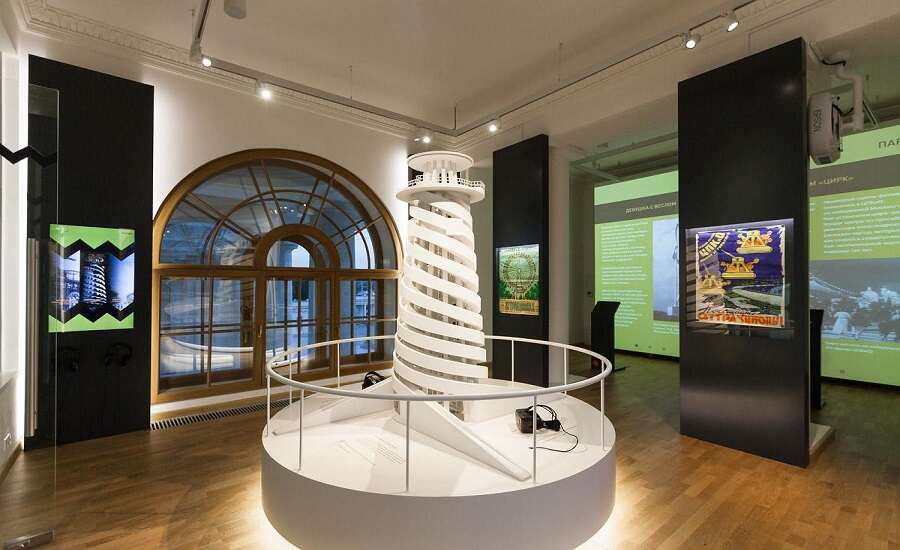
Photo from http://themedium.ru/
Visit the Gorky Park Museum, located in the left pier of the entrance arch. The current exhibition is dedicated to Gorky Park in the ‘golden age’ of the 1930s, and shows the development of Moscow’s central park through the eyes of Betty Glan. There is an observation deck on top of the arch, which offers a lovely view over the park and Moscow’s skyline.
Did you know? In the entrance arch there is also a gift shop where you can purchase balls, frisbees, blankets, and other items to enjoy your visit to Gorky Park.
Garage Museum of Contemporary Art
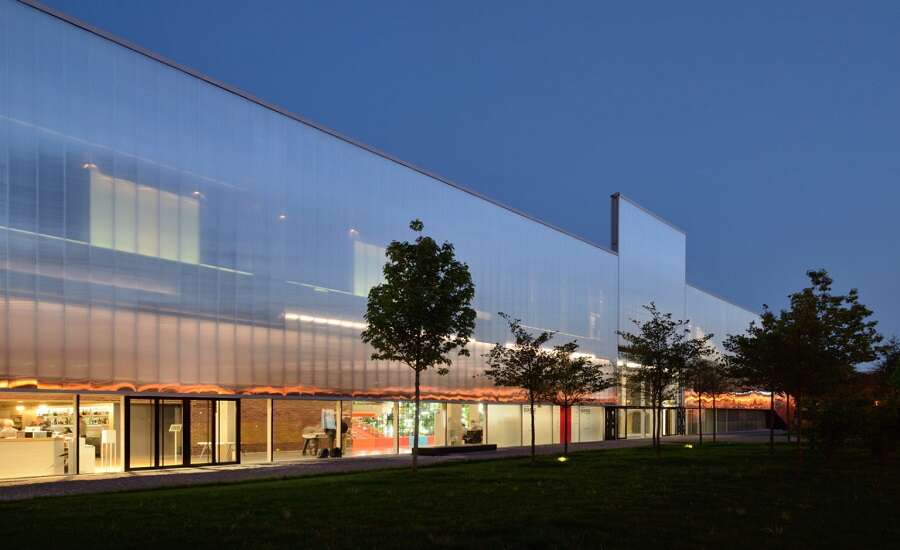
Photo from https://muzeolog.com/
In Gorky Park you will find Garage Museum, Russia’s first philanthropic institution dedicated to contemporary art, founded in 2008 by Roman Abramovich and Dasha Zhukova. 10 major exhibitions are hosted each year to showcase the work of established and up-and-coming artists. Also organised are a rich programme of events including curator-led excursions, workshops, masterclasses, lectures, concerts, performances, festivals, and film screenings at Garage’s outdoor cinema. Read our article about Garage Museum of Contemporary Art to learn more.
Food and drink
There are plenty of excellent cafes and restaurants dotted around Gorky Park, where you can stop for a quick coffee or enjoy a long meal with a view. They include the stylish lakeside café Ostrovok (Little Island) and upmarket restaurant Vremena Goda (Seasons) which serve European and Russian food, colourful lakeside Thai restaurant Lebedinoe Ozero (Swan Lake), trattoria Merkato with its huge summer terrace, restaurant Syrovarnya (Cheese Factory) with a menu focused on its homemade cheese, food-truck court Restoparking which is stylised as a drive-in café, and ice-cream and tea shop Chaynaya Vysota.
What’s nearby?
Gorky Park is bordered by Muzeon Park of Arts, Neskuchny Garden, and Sparrow Hills Nature Reserve. This huge ensemble curves for eight kilometres along the bank of the Moskva River, providing a beautiful oasis of green in Europe’s biggest city.
Muzeon Park of Arts

Photo from https://new-magazine.ru/
Muzeon Park of Arts is the largest open-air sculpture museum in Russia, home to 1,000 sculptures by Soviet and Russian sculptors, including those by famous artists. A large part of Muzeon is occupied by the New Tretyakov Gallery , which houses Russia’s most complete exhibition of national art from the 20th century to the present day. The pedestrianised Krymskaya Embankment which extends alongside Muzeon has recently undergone redevelopment, and is one of Moscow’s most popular spots to relax.
Neskuchny Garden
Neskuchny Garden is the oldest park in Moscow, founded in 1728 by Prince Nikita Trubetskoy, who threw fantastic festivities in his manor house and gardens – neskuchny means ‘merry’ in Russian. Many other noble families also built their country estates in this area, which became a public park and garden after being acquired by the royal family. Today, the Neskuchny Garden is home to historical buildings, fountains, and gardens from the 18th and 19th centuries, sports facilities, an open-air theatre, and a huge greenhouse which supplies flowers to Gorky Park.
Sparrow Hills
Sparrow Hills Nature Reserve is a huge forest park lining the steep bank of the Moskva River and the only specially protected nature area near the city centre. It is home to ecological trails, ponds, natural springs, rare species of plants and animals, many spots for picnicking, cafes, and a mini zoo. At the bottom of the park lie the Vorobyovskaya and Andreevskaya Embankments, with promenades along the Moskva River, a beach, and piers offering boat trips. As with Gorky Park, Sparrow Hills is hugely popular for sports and outdoor activities in all seasons. A new winter sports complex with snowboarding, ice skating, and ski tracks and jumps is currently under construction. When the weather is pleasant, you can rent a bicycle to ride the 8 kilometres along the river from Muzeon to Sparrow Hills.
Essential information for visitors Address and contact details Gorky Park, Krymsky Val, 9, Moscow, 119049 Website: https://park-gorkogo.com/ Email: [email protected] Telephone: +7 (495) 995-00-20 Nearest metro: Oktyabrskaya (570m), Park Kultury (860m) Opening hours and tickets
Related Tours
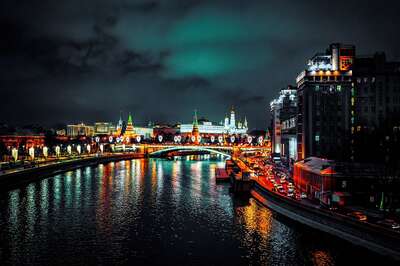
Highlights of Two Capitals
This is a well-balanced tour of Moscow and St. Petersburg that includes all must-see sights, such as the Kremlin, Red Square, the Peter and Paul Fortress, Peterhof with its world-famous fountains and, of course, the Hermitage Museum.
Accommodation
PRIVATE TOUR
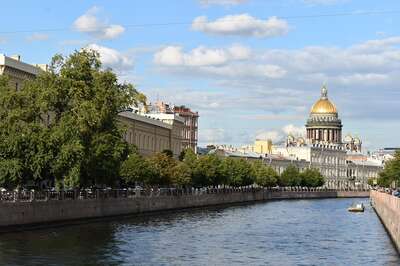
Jewels of Two Capitals
It is our most complete and popular tour of Moscow and St. Petersburg. In addition to visiting all the emblematic places, you will also have free time for your own discoveries. On your free nights you can watch the shows at the Bolshoi and Mariinsky Theaters or a folkloric show.

Classic Moscow
This is our most popular Moscow tour that includes all the most prominent sights. You will become acquainted with ancient Russia in the Kremlin, admire Russian art in the Tretyakov Gallery, listen to street musicians as you stroll along the Old Arbat street, and learn about Soviet times on the Moscow Metro tour.
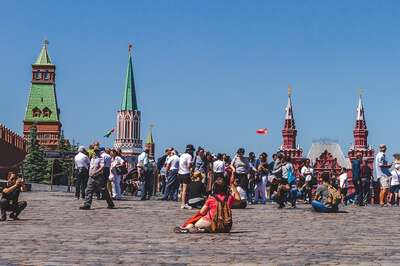
Group Tour Moscow Break by Intourist
Russia's capital has so much to offer, from the Kremlin and the Metro to the Old Arbat street and the Tretyakov Gallery. Besides these sites, you will also visit a fascinating country estate which today is quite off the beaten path, Gorky Estate, where the Soviet leader Lenin spent the last months of his life.
Our travel brands include

Express to Russia
Join us on Facebook
We invite you to become a fan of our company on Facebook and read Russian news and travel stories. To become a fan, click here .
Join our own Russian Travel, Culture and Literature Club on Facebook. The club was created to be a place for everyone with an interest in Russia to get to know each other and share experiences, stories, pictures and advice. To join our club, please follow this link .
We use cookies to improve your experience on our Website, and to facilitate providing you with services available through our Website. To opt out of non-essential cookies, please click here . By continuing to use our Website, you accept our use of cookies, the terms of our Privacy Policy and Terms of Service . I agree
:focal(1500x1000:1501x1001)/https://tf-cmsv2-smithsonianmag-media.s3.amazonaws.com/filer_public/64/a8/64a8f437-3efb-47fc-8c53-7bc977b042b7/lofoten_islands_fishing_cabin.jpeg)
Northern Europe and the British Isles
Explore the region's history, culture and natural wonders.

The Royal Family Is Opening Balmoral Castle to the Public For the First Time in History
:focal(2850x2144:2851x2145)/https://tf-cmsv2-smithsonianmag-media.s3.amazonaws.com/filer_public/23/d3/23d3b8ab-f137-4390-834c-a76f41c5be7f/mar2023_e05_puffins.jpg)
An Icelandic Town Goes All Out to Save Baby Puffins
:focal(2016x1517:2017x1518)/https://tf-cmsv2-smithsonianmag-media.s3.amazonaws.com/filer_public/29/c3/29c3c7e8-3306-4066-a64d-00a43378540d/img_4838_2_1.jpg)
How Scotland Is Reinventing Its Centuries-Old Canals for Paddlers
:focal(2860x1907:2861x1908)/https://tf-cmsv2-smithsonianmag-media.s3.amazonaws.com/filer_public/05/37/0537d8a1-37ed-41b2-9b9d-964c59535230/gettyimages-1237797266.jpg)
The English Farmers Who Harvest Rhubarb by Candlelight
:focal(615x416:616x417)/https://tf-cmsv2-smithsonianmag-media.s3.amazonaws.com/filer_public/e6/97/e697f97a-06e3-4adb-ae31-ca399515c0c5/unnamed.jpg)
Hoyma Is Bringing Music Home in the Faroe Islands
:focal(512x346:513x347)/https://tf-cmsv2-smithsonianmag-media.s3.amazonaws.com/filer_public/31/56/3156b309-f34e-4633-a465-73432a18df99/gettyimages-1250745691.jpg)
How a Victorian Dinosaur Park Became a Time Capsule of Early Paleontology
:focal(1826x1374:1827x1375)/https://tf-cmsv2-smithsonianmag-media.s3.amazonaws.com/filer_public/d0/cb/d0cb8953-673e-4670-966b-4a3c43b40994/1_-_56dbd132-67d0-423c-8a7f-928416be7ec5.jpg)
Get an Eyeful of Iceland in These 15 Photos That Capture Its Natural Beauty
:focal(800x602:801x603)/https://tf-cmsv2-smithsonianmag-media.s3.amazonaws.com/filer_public/a0/a7/a0a798b3-d11c-4cb3-8d49-c73162a0c5c2/web_opener_v2.jpg)
The Grand History of Westminster Abbey
:focal(870x655:871x656)/https://tf-cmsv2-smithsonianmag-media.s3.amazonaws.com/filer_public/64/cb/64cb1ef2-92c6-46a0-a96e-862b0141939f/openerpygmyreindeer.jpg)
The World’s Smallest Reindeer Get Their Day in the Sun

IMAGES
VIDEO
COMMENTS
Virgin Galactic is launching a new space age, where all are invited along for the ride.
Photo courtesy of Blue Origin. Blue Origin is the other major space tourism company, founded by Amazon billionaire Jeff Bezos way back in 2000. Bezos plans for Blue Origin to offer both commercial launch services and space tourism launches. Unlike Virgin Galactic, Blue Origin plans to use rockets and passenger capsules to send space tourists to the edge of space.
Currently, Blue Origin has a Federal Aviation Administration license for human space travel through August 2021. If the first crewed flights are successful, the public can potentially start space ...
Space tourism is human space travel for recreational or leisure purposes. It's divided into different types, including orbital, suborbital, and lunar space tourism. ... As space tourism became a real thing, dozens of companies entered this industry hoping to capitalize on renewed public interest in space, including Blue Origin in 2000 and ...
Jason Lyon. By Debra Kamin. May 7, 2022. Ilida Alvarez has dreamed of traveling to space since she was a child. But Ms. Alvarez, a legal-mediation firm owner, is afraid of flying, and she isn't ...
5) SpaceX stacks tallest booster ever with Starship. SpaceX's first orbital Starship SN20 is stacked atop its massive Super Heavy Booster 4 for the first time on Aug. 6, 2021 at the company's ...
Space Perspective: "Hot Air Balloon" to Stratosphere. Price: $125,000. Flight altitude: 30 kilometers. What you'll get: A relaxing six-hour ride to the stratosphere in a balloon-borne ...
Leisure travel might be a little more exciting for the world's wealthiest adventure seekers as space, long the exclusive domain of professional astronauts, is now accessible to tourists. ... At the Kennedy Space Center, for example, public affairs officers facilitated increasing access to NASA's launch complex between 1964 and 1967. Their ...
Space Travel. The path to the Moon, Mars, and beyond requires technologies to get us where we need to go quickly, safely and efficiently. Space travel includes launch and in-space propulsion systems, cryogenic fluid management, and thermal management, as well as navigation and landing systems to get our supplies, equipment, and robotic or human ...
She'll be only the fourth Black woman from the US to travel to orbit. Chris Sembroski, a 42-year-old Seattle-based Lockheed Martin employee and former camp counselor at Alabama's famed Space Camp.
The target date is from late 2021 to early 2022. Yusaka Maezawa. Japanese billionaire Yusaka Maezawa is striving to be the first civilian to orbit the moon. He signed a partnership with SpaceX for ...
Even the ever-optimistic Elon Musk puts the minimum cost of space travel at $10 million per flight. In an interview, Musk stated that the "cost efficiency of SpaceX is the best in history," and it is "designed to be fully reusable.". This means that, according to Musk's quick math, the cost of SpaceX is around 5-10% of the Saturn V ...
Orbital space travel refers to a space flight in which the spacecraft remains in space for at least one orbit. The estimated revenue of the orbital space tourism market worldwide amounted to ...
Derek Webber, Director of Spaceport Associates in Rockville, Maryland said that a good start has been made in making a business case for public space travel. For one, the success of the Ansari X ...
Public space travel is a going and growing industry, but with a number of hurdles to overcome before becoming a sustainable and profitable marketplace. There is already over $1.5 billion invested ...
To develop the concept of general public space travel and tourism further, and to bring together representatives from our space-related government and university interests, the travel and tourism business, the financial community and the aerospace industry, a Workshop was held during February 19-21, 1997. The primary purpose of this Workshop ...
Travel and tourism is one of the world's largest businesses. Its gross revenues exceed $400 billion per year in the U.S. alone, and it is our second largest employer. U.S. private sector business revenues in the space information area now approximate $10 billion per year, and are increasing rapidly. Not so in the human spaceflight area. After spending $100s of billions (1998 dollars) in public ...
Space exploration unites the world to inspire the next generation, make ground-breaking discoveries, and create new opportunities. Technologies and missions we develop for human spaceflight have thousands of applications on Earth, boosting the economy, creating new career paths, and advancing everyday technologies all around us.
The pressurized capsule - designed by the legendary Frank Stephenson, the automobile designer for Ferrari, Alpha Romeo and more - measures 5 meters (16.5 feet) wide and 3.5 meters (11.5 feet ...
This colonnade shares the same configuration in a way, as people travel through the columns and move about the space. People tend to stand or lean against the recessed space or columns. The central hall in Okhotny Ryad Station is another version of an active underground public space (Figure 11).
Public Space Travel: Reality or Mirage? Virgin Galactic released this sneak peak of the new SpaceShipTwo suborbital spaceliner (center) attached to its carrier aircraft just ahead of their Dec. 7 ...
With so much space, Moscow seems to be the ultimate Arendtian representation of the public realm. As explored in the Moscow Omeka blog post focusing on the city's various parks, urban spaces play an especially important role in Moscow, a city cmoming to terms with its past to enter the world stage as a post-Socialist city. The advent of public space is an important part of discussion for ...
Millions of people travel through undergr ound spaces every day in any city with a . subway system. ... Public space plays an important role in sustaining the public realm. There is a renewed ...
American Tourists Aggressively Stop Locals in Durango, Mexico from Watching Eclipse in Public Space. On April 8, many in parts of the United States and Mexico were gearing up to watch the total ...
Telephone: +7 (495) 995-00-20. Nearest metro: Oktyabrskaya (570m), Park Kultury (860m) Opening hours and tickets. Gorky Park is Moscow's most famous park, beloved by Muscovites and tourists alike who visit in all seasons to stroll, play sports, admire the park's attractions, and attend events.
Northern Europe and the British Isles. Explore the region's history, culture and natural wonders. Made Possible Through the Support of. Lofoten Islands, Norway Harry Zimmerman/Smithsonian Magazine ...